The Lawmatics Blog
Insights on legal marketing, automating the law practice, and legal tech in general
About the session
Behind every great client experience is a system quietly keeping things on track. The newest automation updates in Lawmatics build on that foundation, making it even easier to build and manage their automated workflows.
In this session, Devon Butler and Clare Struzzi walk step-by-step through what’s new. They cover trigger-based automations, appointment workflows, shared entry rules, and a simple way to organize everything in folders. Together, these improvements give firms even more control, flexibility, and time back in their day.
Webinar slide deck
1 Understand your law firm as a business
You didn’t go to law school to learn how to run a business. But at the end of the day, you provide a service to customers. If you understand your firm as a business — and look for ways to improve your operations as a business — you’re setting up your firm for success. In turn, you’re putting yourself in a better position to set clients up for success.Communication is at the center of any successful business operation. In the legal world, clients (i.e. customers) can often feel overwhelmed about a process they may not understand. Feeling out of control and out of the loop is a recipe for a dissatisfied client — and is why insufficient communication is one of the most common bar complaints against attorneys. A client intake process designed to over-communicate at each step of your client’s journey will lessen their anxieties, and make them feel more at ease in the hands of your firm.
2 Understand the client journey
Quality customer service is what separates good law firms from great law firms. To maximize opportunities to delight your clients, you have to meet them where they are. With the right tools and process, you can create a seamless personalized experience for each client.Ask yourself critically: when does your client’s journey actually start, and when does it actually end? Does it only start when they sign an engagement agreement? Does it really end when they’ve paid their last invoice?The reality is that the client’s journey with your firm starts before they even schedule a consultation. Your client’s experience with your firm’s intake process — how easy it is to find your firm and make an appointment — forms their first impressions of the quality of your customer service and your effectiveness as a firm.Keep in touch with clients after their matter has concluded. Something as small as sending an email on their birthday improves their customer experience and increases referral opportunities.
3 Automations are a necessity for modern law firms
It’s become almost physically impossible for law firms to rely solely on manual processes to provide robust experiences throughout the client journey. Consumer expectations in the digital age demand immediate engagement, clear communication, and convenience. Automations are a necessity to create a seamless experience that can keep up with the demand of the client intake process.With automations, you can engage clients immediately at the start of their intake process, even if you’re not available. Expand your capacity to delight clients with personal details, like sending a birthday card or newsletter, without additional administrative labor. With automated follow-ups, make sure nothing slips through the cracks or gets lost in the shuffle.
Takeaways
In any kind of consumer-driven law practice, your client’s matter is likely the most important thing going on in their life. Your client intake process should reflect that. Give clients the convenience of booking a consultation on your website. Give them peace of mind with an automated confirmation email. Use the tools at your disposal to engage your clients at every stage of their journey. Take a step back and ask yourself, “How would I want to be treated if I came to this law firm with a matter that was the most important thing in the world to me?” Let your answer be your lodestar.
Podcast transcript
Allison Williams
Hi, everyone. It's Alison Williams here, your Law Firm mentor. Welcome to another episode of The Crushing Chaos with Law Firm Mentor podcast. Today, I have a special guest for the podcast. His name is Matt Spiegel. Now I'm sure you know who he is even though you may not necessarily know his name because he is someone that I consider to be a big innovator in the legal space. He helps lawyers in a variety of different ways, but the ways that you guys probably know about is practice management software MyCase. He is founder and CEO of MyCase, and he is founder and CEO of Lawmatics.Now, the beautiful thing about bringing Matt to the podcast is that we got to talk about both aspects, practice management software and legal automation. I know that these are two areas where we get a lot of requests. People that reach out to the podcast will say, "Hey, you did a show on such and such or so and so. I'm really interested in learning more." And almost universally, that deals with some form of efficiency tool for our law firms. Because we all know that with each day and each moment that passes more and more data, more and more people come into our orbit, and managing that effectively is what is going to keep us out of the realm of grievances and malpractice suits.So we actually talk about bar grievance and we talked about Matt having had a bar grievance. I personally had one as well. And when people make complaints, it usually is not because they didn't get the result that they wanted. Most clients can intellectually understand that you can't wave a magic wand and get them to a great result, but it's how they felt in the process. And so, how do you get to a better client experience for your customer? How is it that your client can get the star treatment when there are only so many hours in a day?The answer is automation. So Matt and I talk about that, but I want to let you know that Matt is a serial entrepreneur. He is actually a lawyer. He still has his law license. No longer has his law firm, but he was a law firm owner. And through the experience of being a law firm owner, he created the solution that he needed in practice, which was the tool of MyCase, which started off as a client portal, which you're going to hear more about when we speak.He also then founded Lawmatics. After a break from MyCase, he shifted over into the world of legal tech automation, and it's really interesting how he got there. He is somebody who actually is scaling Lawmatics. The way we talk about scaling law firms, he's scaling Lawmatics, it is a venture-backed company, and their approach to automation may be a little bit different than you realize. Something you may or may not have heard before. So you're going to hear it here on the podcast. Check out my talk with Matt Spiegel of Lawmatics. Here you go.All right, Matt Spiegel, welcome to The Crushing Chaos with Law Firm Mentor podcast.
Matt Spiegel
Thank you, Allison. I'm very, very excited.
Allison Williams
So it's great to have you here. I'm really excited that we have the chance to connect. Because I think what you do is somewhat similar to what I do in the sense that you started a law firm, you had experience from that, and then ultimately you grew into serving lawyers from your experience with something very specific. And in this instance, you did both practice management software and automation, and you refer to yourself as a serial entrepreneur. So talk to us a little bit about what that journey was like for you.
Matt Spiegel
I appreciate you saying that we're similar, although I would think that your story and journey is a bit more impressive and you're juggling more than I'm juggling probably at once. So I appreciate you putting me in the same light, but I'm really impressed with things that you do and you are doing, and there's other people in the same situation as you, which just continues to impress me and also fuel the industry a bit. It's been really cool to see the growth of podcasts in the legal space. It's not just non-lawyers out there preaching for their products. It's actual people like you helping, which is awesome.For me, it was a bit of luck, maybe opportunity at the right time, which I think always is part of it, but it was a fun journey for me. I was like everybody, like most listeners, I am a lawyer. I obviously don't practice anymore, but I still maintain my license. I was a criminal defense lawyer, as cookie cutter as it gets. I started my own practice and it was very quickly in starting my own practice that I had an itch that I needed to scratch, which I think is the way that this happens for a lot of entrepreneurs. It's kind of a tale as old as time. You start doing something and you're like, "Man, this is difficult. I wish that there was the way to do this better." Then if there isn't, you decide to build it yourself.And so, that's kind of what happened, and it's how I ended up starting the company MyCase. It just started out of a need that I had at my own law firm. I think I've always been a little bit more business-centric when I started. I went into criminal defense, quite frankly Alison, because I thought it would be a good business to run. I thought that consumer-driven law, especially criminal defense, was something that you could sort model a franchise off of. You could create a process that was going to be repeatable for each client. You could have a fee structure that was repeatable. So I liked it from a business standpoint. That's one of the reasons why I went into that area of law, and transitioning into building software companies felt somewhat natural for me.
Allison Williams
So I love that you actually own the fact that you had a business mind when you were approaching your law practice. Because I think, first of all, it's very unique. I think a lot of us, we start practicing and then we figure out that we happen to be in a business. But you really had a very different perspective on that, and it informed both the practice area that you chose and the way that you approached business. So talk to me about what was missing in your business that you saw that was a hole in your law practice that you filled by virtue of creating MyCase.
Matt Spiegel
At the time, and so to piggyback off that point, because you make a very good point and I think we'll probably talk about it a lot more today, but that's one of the problems, is that lawyers don't think about their law firm like a business as much as they need to. They just think about it as being a lawyer. But for me, that moment, it was actually client communication. I think very few people know this at this point. But when we first started MyCase, it was not a practice management software. It was simply a client portal. It was the first ever client portal, but that's all it was and we tried to launch it like that. It was met with awful response. Lawyers were like, "Okay, this is cool, but this should be part-"
Allison Williams
I got dropouts for that. We go for that.
Matt Spiegel
Or, "This is great. This is useful, but it needs to be part of a bigger system." And so, that's ultimately how we ended up building the full practice management system around client communication. But the catalyst was, it was actually, to be honest with you, Allison, it was a bar complaint. I got a bar complaint and it was stupid. It wasn't like that I was a bad lawyer. It wasn't that I got a bad outcome or that it was malpractice or ineffective assistance accounts or anything. It was quite literally, "I didn't call you back quick enough." It was attorney-client communication. And so then I went down-
Allison Williams
Number one complaint, by the way that we'd get.
Matt Spiegel
It was the number one complaint in 2009, and it's still the number one complaint. It's ridiculous and actually embarrassing that that is still the number one issue that we have as lawyers. But that's what caused this, that's what kicked off this whole journey for me was a bar complaint.
Allison Williams
Well, bar complaints, we don't talk about them a whole heck of a lot. In fact, we ought to do a whole series here on Law Firm Mentor, on the podcast, about bar complaints because they're embarrassing when you experience them, but they cause a lot of terror in the hearts of lawyers. It's usually because of some inefficiency in the business that cause either a breakdown in communication or a disconnect in expectations or a lack of client service. That pisses off a client so that they find something to point at whether it's right or it's wrong. Then ultimately, the lawyer is raked over the coals while the bar is trying to find the justification of whatever the person said.So you actually were not just ahead of your time in terms of proactively dealing with that for your own business, but very much on what I would refer to as the cutting edge in terms of pulling together the client journey and the client-centric approach with the necessities that we have of sending out our bills and getting our calendar organized and making sure that our client documents are all cataloged together.So now, I want to shift and talk about how that really fits with your second venture. And I just have to acknowledge this. I just recently hired a lawyer for what is now going to be my third business. That lawyer told me you're going to get your bill through Lawmatics. So it's kind of ironic that you and I are talking today, but those two pieces fit very well together. So let's talk about Lawmatics. Talk about the evolution of all that you learned as the innovator behind MyCase and what you created as a foundation that grew, and then transitioning over into the automation kind of toolkit that is Lawmatics.
Matt Spiegel
It's a good question. I don't know if the story is all that exciting, but I'm happy to share it. The truth is that Lawmatics ultimately was born out of what I experienced. And so, I left MyCase in 2015 and I went and did some other things for a few years. When I look back it feels like I was gone from the legal industry for six years, but apparently I was only gone for two years. So in 2017, ultimately I wanted to start my own business again because I was running a company that had nothing to do with legal, and I was reporting to a chairman and I was like, "I just wanted to do my own thing again." Quite honestly I wanted to go back into legal.What I understood was that back in 2014 at MyCase, we started to see lawyers, they were showing signs of thinking about things a little differently. They were showing signs of starting to prioritize the business side, especially on the solo and small firm side of the market. They were starting to show signs of thinking about their business. As tech companies, we've always had these tools that are 100% business driven. They are designed to give us KPIs on how our business is performing. Things like Salesforce or HubSpot or Infusionsoft or whatever CRM we were using to give us insight into our business.I started to think that, "Man, if lawyers start thinking about things from a ... " Well, actually it really came from my own law firm too, because I was thinking about things very economically. When it came to my law firm, I was looking at things like acquisition cost, cost per lead. To me, it was formulaic. If I could go and spend this much money for a DUI case and a DUI case brought in this much money, it's a formula. And so, I thought to myself, I'm like, "Man, these business metrics, that kind of dashboard KPIs that I'm used to getting as a tech company, why wouldn't lawyers want that? They're a business just like anyone else."And so, we started to see that shift in 2014. We started to hear it come up like, this idea of a CRM or business kind of insight tools. So fast forward to 2017, and looking back at something I knew was a kernel of an idea three years prior was now starting to become a little bit pick up some steam. And so, we decided that there's a massive gap in the market for this, for a true business intelligence CRM backed up with the foundation of which would be automation because that's what drives a lot of these products that we were used to. And so, that's ultimately what led to us going down this path, and it has been a winding journey for the last five years now, and we're really just getting started.
Allison Williams
So as you talk about how you got here, because you have this mind that goes to the KPI, you asked the question that I think was very poignant which is: Why would a lawyer not want all of that data available to them so that they could be more effective in delivering a metrics-driven process and service to their client? And I'll tell you why. Because lawyers have some really fucked up thinking.
Matt Spiegel
You said it. You said it.
Allison Williams
Let's just own it. I said it all right. We're not going to put that on you. But there are a whole lot of us that have the fear that, we get taught we're a professional, and that somehow is antithetical to being good in business.
Matt Spiegel
Exactly right.
Allison Williams
And so, if you're focused on how do I deliver this service as economically and efficiently as possible so that I can generate the most profit off of each person I'm serving, we think that that is somehow not in the client's best interest. So therefore, we're prioritizing ourself over the client which, of course, is nonsense because I always say the worst thing for the public is a broke lawyer. As soon as we have to figure out if we're eating this week and we have to decide whether your deposition is something we should spend money on because we have a family to feed, that is where we start getting into trouble with ethics and with choice over client. But when a client is actually being served well, and the lawyers being served well, it's a win-win. Everybody's happy or as happy as can be with their legal problem in that scenario.So automation really does help that. And it really is something that I think you're right. There is a movement in our profession to get people on board with that. So how does Lawmatics really take the lawyer who has that messed up thinking and they don't quite understand how to get into the numbers of their business? They know that they should, but they don't know how, it's overwhelming. It feels very outside of what they learned as a lawyer. How do they take a tool like Lawmatics and really automate their entire law firm?
Matt Spiegel
It's a good question. Here's one of the ways I look at it is I don't think that lawyers, I think the catalyst for going into automation, is not necessarily like, "Oh, I want to automate." It's more, "I want to provide a better service to my clients," or "I want to be able to have insights into my business." You're asking yourself those questions. It just happens to be that in order to answer those questions, I think you have to have automation. So to me, as a business owner, law firm or any business owner, it's asking the right questions first, which is what leads you down the path of how to automate and what to automate.But I'll give you an example, lawyers that are doing a lot of advertising. Let's say you're advertising on Google or you're advertising on Facebook or wherever it is that you're advertising, but you're spending some money on digital advertising, which my guess is most of our listeners today are doing that. If they're not, they probably should. But that's a different topic altogether. But the point is, and I work with a lot of law firms not just in the capacity of Lawmatics. I will constantly I'll help friends or random people that reach out that just want a little bit advice on whether it's marketing or how to maybe drive more leads and things like that.One of the things I will tell them is, "Look, you can go and spend money on marketing, that's great. But if you cannot measure that marketing, then you shouldn't do it." I don't care if it's going to be the best marketing source, if it's going to bring in a ton of leads and you're sure of it, if you can't measure it, don't do it. The reason is because when you start throwing money at a bunch of different things, you're not going to know what's working unless you have analytics to drive that. You end up spending a ton of money. You're just putting money into a bucket that has holes in it. It's just blind. You have no idea which hole the water's coming out of. There's a bunch of water getting stuck at the bottom, but there's also water going out these holes, and you have no idea which one to plug unless you have reporting and analytics.And guess what? The only way to get analytics and good reporting on where your leads are coming from is to have some automation that is driving that. Something that says, "Okay, this person came from here so I'm going to automatically associate it with this campaign. I'm going to do whatever it is that you want to do to identify that it came from a certain source." And that can happen at any part point in the process, whether it's the moment that that lead comes into your website and fills out a form, the moment that they call your receptionist or call you, or during the intake process, after they've come in. There's different parts of the process You're going to identify where somebody came from. It's important to have automation designed to handle that. Then you can report on it, and then you can get the metrics that you need to make very sound business decisions.
Allison Williams
So when a lawyer says, "I want to dive into this, but I think it's going to be overwhelming for me to even understand things like cost per lead and cost for client acquisition," aren't those the same thing? How are they different? How do I learn it all? How does using an automation tool help facilitate that knowledge and where does the rubber meet the road? Is this something that you only do once you have a certain amount of volume of lead flow? Once you have a certain revenue stream? Where is the entry point for somebody who wants to give their clients a better service, who wants to know their business better, but just doesn't know where to start?
Matt Spiegel
That's actually a really awesome question because there's no rule. There's no, oh, when you reach this amount of clients, then you're ready for an automation or a CRM or business intelligence. If you are interested in providing a better service to your clients, which you absolutely should be, then you absolutely need a tool. The reason is because, and I look at it in terms of the full client journey. So, what does it look like at your law firm when a client from the moment a client comes in and finds you all the way through until after their case is over with you? That entire process is the client journey.There's three phases. Phase one, intake phase. They're trying to determine if they want to hire you, and you're trying to determine if you want them as a client. Phase two is there's an active case. You're handling a matter for them. Most of the time there's a start and end date to that. In family law, there certainly is a start and end date. That end date may be a little ambiguous, but there's sort of an end date. Criminal offense, there's obviously very much a start and end. Phase three, which is the most neglected, I think Allison, is after the case is over. They are a former client. If you are not doing things to engage that former client, you are losing out on business categorically.I always ask the question to people whenever I'm talking a big group is, "How many people here have more than 500 old clients?" Everybody raises their hand. "Well, how many of you are sending them notes on their birthday?" Then every hand goes down. Because they're like, "Well, I can't send everybody an email on their birthday." Well, you can. You just need automations. You just need automation for it.So I think when you look at it in terms of that, think about delivering, at what point of the relationship, the whole journey, can you deliver an amazing experience that delights your customer? Because I will share a bit of insight that I believe very strongly in. I believe that you could be the best lawyer in the world and provide bad customer service and fail. But I also believe the flip side to be true. Maybe not the worst lawyer in the world, but you could be an average lawyer or maybe even a little bit below average, but provide the best customer service in the business and you can be successful. I think that that's something really important that lawyers lose sight of. I think if you think of businesses outside of law that have really good customer service scores, their products are not necessarily better than anyone else. Sometimes maybe their products are inferior, but the customer service, the experience you get brings you back. It's the same with law.
Allison Williams
It is 100% the same with law. Since you mentioned customer service, ironically, I was just with my family at an engagement party over the weekend. A story that I told on social media came up again and it was about the infamous coffee. I won't out the hotel chain, but there is a hotel chain, very well known, that had a conference, and I was staying at a companion property of theirs because the primary property was sold out. At the companion property, they had golf carts that would take you over to the main property at the time of the meeting. And so, on checkout day, I wanted to leave my property. I wanted to leave my bags at the front of the hotel, take the golf cart over to the meeting, and then have my bags delivered so I could go to the airport.As I'm about to leave, I ask for a cup of coffee as I'm in the waiting area. I was told that coffee was not available, but I could buy a K-cup for, I don't know, $5, $3, whatever it was. I was just stunned. I sat there and I looked, I was like, "Let me get this straight I'm spending ..." I'd actually look it up, "$504 a night for the hotel room, and you're going to try to sell me a K-cup." You realize how stupid a business model this is. You could literally charge me an extra dollar. If I'm spending 504, I would have spent 505. You could have made a dollar on every human being in here and made more money by just including the lesser included offense of the coffee in the lobby. But it was the lack of foresight at some level, I'm sure very far, far up the food chain in corporate that led to that result. The offense to the client or to the customer because of just doing things in the way that we're doing things and kind of tacking something on.Automation very much lends itself to taking out that residual. Because when you start to understand numbers as a result of understanding things like how much it costs to acquire a client, how much it takes to deliver a service, you can start to find ways to not just make more money, but to deliver a better service and a better experience so that the person who is being served by you actually perceives it better.
Matt Spiegel
It's a 100%. I think it's funny, right, because your example is very similar, and I know this is what got you thinking about it, but the thing that you off had actually nothing to do with the real product. They're a hotel. It didn't have to do with your stay there. It was something ancillary that could have very easily been addressed. That's often what happens. It's the same thing with law. It's not necessarily the outcome of the representation. It can be something that's unrelated, that's customer service generated. And so, my point is that you're going to start to look at your law firm and think, "All right, what are all the different areas, the steps of the journey that I can delight my customer? Oh, you know what? I can just engage them immediately as they come in even if I'm not available. I can send everybody an email on their birthday. I can have newsletters going out to my current clients, keeping them up to date with things that I'm researching to stay on top of trending issues for their case that I'm representing them on."And guess what? You might be hearing me say that and thinking to yourself like, "Oh my God, that's impossible. How am I going to do all that?" You can't. I'm saying you should do this. You should think about all these different ways that you should delight your customer. But I'm telling you that you can't just do it yourself. You have to have automation to take these things off of your plate because no lawyer is going to be expected to go have a calendar that has all their clients' birthdays on it, and then they're going to go and send an email every day to the four or five clients that have a birthday. Automation is there to help you with this.
Allison Williams
Well, the beauty of it, I mean, since you mentioned that, I know someone who actually does do quite a bit of automation of not just the phase two as you described it, the delivery of the service, but it is in delivering the essentials. Because you talk about delighting your client, and we know, especially I deal in family law, so of course I have a lot of very unhappy humans that were otherwise nice people before they decided that their spouse was the spawn of Satan and they had to escape. But most law clients are not happy. Most of them are dealing with some type of troubling, traumatic, challenging issue in their life. So you are a very easy target for them because you are the thing, the buffer between the resolution. The resolution may be positive or negative, but at least it's over. That trauma that they're going through from problem to solution, you're on that pathway.I know a law firm in Minnesota, I won't name them because I don't have permission to, but very exceptional law firm. They actually automate all of the communications from the start of the case to the end of the case. So all of the education about this is what the next conference is about, and this is what the next, every time we get a letter from the adversary here is how we are going to approach this. They get so much in the automation pipeline that clients are getting an inundation of data and information so that there's never a time that a client actually has to wait to ask a question. It's almost like their FAQs are on redux and they're constantly being given to them.When I learned about that, I thought, "Wow, that's really brilliant if you think about it because so much of clients calls to the office are about the anxiety they feel of not knowing." If you start giving them education every day of their case, they don't really have a time for that anxiety to build. It's still going to build by virtue of life, but it's not going to build by virtue of silence. That oftentimes can ward off things like bar complaints.
Matt Spiegel
Absolutely.
Allison Williams
So, it sounds like you help clients with that process, not just by having the tool, but by the way that your company actually facilitates their understanding of and utilization of the tool.
Matt Spiegel
It's true. So one of the things that we think is important with any tool, it doesn't matter whether it's Lawmatics, whether it's MyCase, or anything, it's important to understand how to get the most out of it. I can't say this about all companies in legal, but I can say this about a lot of them, that they know best practices. They know how to help you with certain things. Kind of tying this back to what we talked about in the beginning about client communication. It's like, there should never be an issue with client communication. You should be over communicating every step of the way and that's one way to delight your customer. You can't do that without automation.The reason why this is important is something that you just mentioned, which I love to talk about as well, which is lawyers lose sight of the fact that with almost every type of law out there, all consumer-driven law, especially family law, criminal defense, this is the most important thing happening in your client's life. No matter what, bankruptcy, family law, estate planning, criminal defense, personal injury, it is the most important thing that they have going on right now. To you, it's just another client. You don't think about it the same way.We need to put ourselves in our client's shoes, and we need to think about like, if this is the most important thing happening in your life, how would you want to be treated? What type of experience would you want? Forget about the outcome. Forget about the letter of the law. Forget about that for a moment. Just think about the way that you would want to be treated. How would you want to be handled? And when you think about it that way, it really, I think unlocks this idea of delighting your client, and you really figure out ways to just create a better experience.
Allison Williams
And so, I think that is such a profound way for us to wrap up today's conversation because it really is about the experience and the fact that automation can help not only the client, but the lawyer to be a better version of themselves. Because the time that you are not expending, thinking through all those communications that you have to have in order to get to the minimum compliance, let alone the delighting stage, you are now going to be able to have an automation tool help you with that. I am platform-agnostic on this podcast. I'm very clear about that. But I know a lot of people that use Lawmatics and I get a lot of positive feedback about how it has transformed the industry. And so, thank you for being a voice and an innovator in this space, and for bringing this level of service and assistance to the lawyers that are out there trying to make their day-to-day experience of being a business owner that much better.
Matt Spiegel
Allison, thank you so much for having me. When we have good chats, I tend to get very passionate and this was an awesome chat, so I appreciate it today.
Allison Williams
Yeah, absolutely. So, one last question. If someone wants to learn more about Lawmatics, if they want to reach you directly, how would they go about doing that?
Matt Spiegel
You can always check us out on our website, www.lawmatics.com. Very easy. You can call, you can explore, you can get a demo of the product. We can just talk in that demo about how you want to automate your firm, what parts maybe are missing for you. So it's not just like, "Hey, this is what Lawmatics does," but we also want to try to give you some assistance and help understand where you're struggling and how we might be able to help or how something else might be able to help. Every customer that comes to us, Lawmatics is not necessarily a good fit. Maybe there's a better fit out there.You can also always reach me personally. I love chatting with lawyers. It's very helpful to me. It's insightful to me, so I really love doing it. Matt@lawmatics.com is my email address. Very easy to get in touch with me there. So I would encourage anybody, if you have any questions or thoughts, feel free to reach out.
Allison Williams
All right. You heard it here. Matt, thank you so much for being here. As I said before, you've been a great resource to the legal community, and of course, by virtue of sharing your thoughts and your experiences here on the podcast. Everyone, thank you again for tuning in to another episode of The Crushing Chaos with Law Firm Mentor podcast. I am Allison Williams, your Law Firm Mentor. Have a great day.

Automation can transform your intake process from one filled with tedious, manual tasks to a well-oiled machine that requires little to no human intervention. What could be better than creating a templated workflow once, knowing that it will run on autopilot and facilitate the same experience for every new lead?Lawmatics has simplified the automation process by creating an easy to use, plug and play Automation builder. Simply select a trigger, add in an assortment of action items, give it an exit condition when needed, and you’re off to the races. While the Lawmatics Automation builder is intuitive, there are a number of tricks and tips that can help you optimize your Automations for maximum efficiency.Though the benefits of Automation are plentiful, if set up improperly there can be pitfalls. You want to make a good impression with all incoming leads and clients, and an Automation misfire sending out an incorrect message is absolutely not the way to do that. The good news is that these kinds of misfires are one hundred percent avoidable. With the following tips you’ll become an Automation pro in time. Read on to learn the secrets of making your Automations work for you, instead of the other way around!
Entry Conditions
When creating a new Automation in Lawmatics, you will be prompted to make several selections right off the bat.
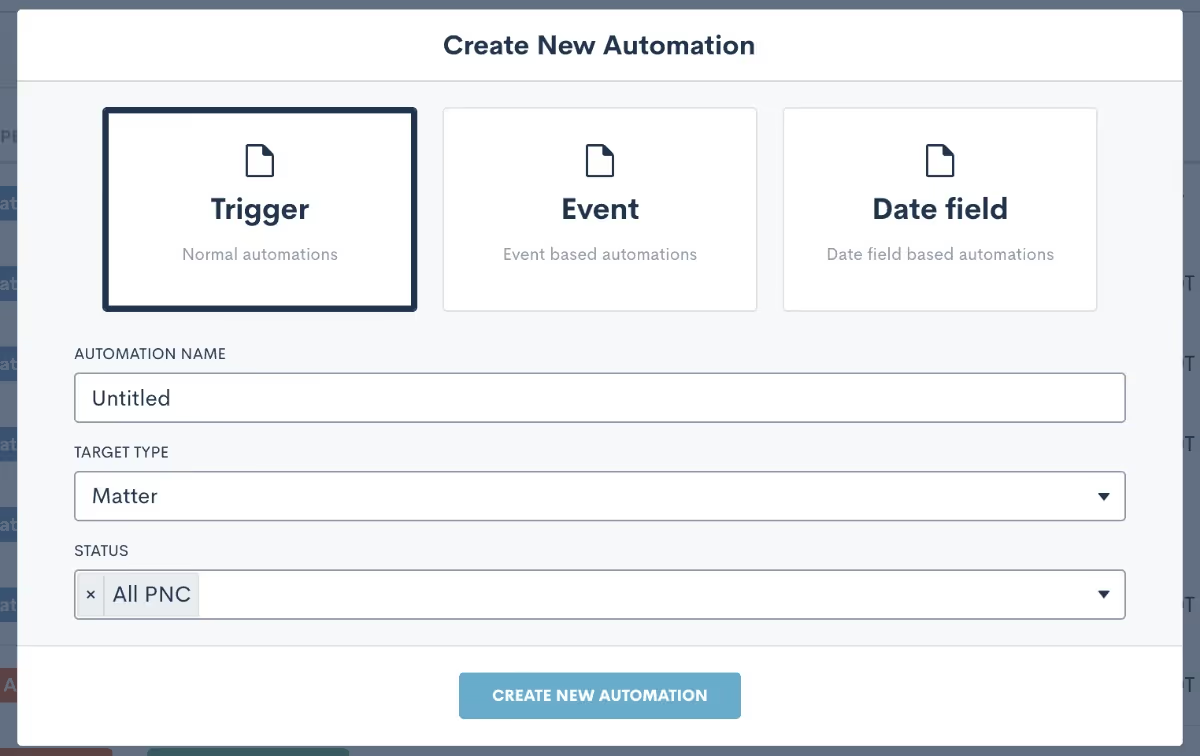
First, select the type of Automation from the options of Trigger, Event, or Date Field. The majority of Automations are trigger-based, meaning that they begin when a specified action occurs. The other two types of Automations are both triggered around the date of either an event on the calendar or populated into a custom date field.Next, you will also need to select the type of your Automation. Most often, the type will be Matter, meaning that the Automation applies to any potential clients or clients. You may sometimes create Automations that are contact type, meaning they could run on plain old contacts like friends, family, colleagues, etc as opposed to only for matters.Last but not least, when the Automation is matter type, you must also select the status that is viable to run in this workflow. If the Automation is purely intake-related, the status will be PNC. Select Hired, Lost, or some combination of the three accordingly.
Pro Tip: Making improper selections at this point can throw your Automation off course, so be sure to pick the proper options or email the Lawmatics support team if you get stuck.
Once you have created your Automation and are in the Automation builder, you will then select your specific entry condition(s). This will be the kickoff or initiator of the workflow. Some of the most common triggers used for intake-related Automations are ‘filled a form’, ‘event created’, ‘match on fields’, and ‘signed a document’.You can also create Automations with more than one entry condition, and choose to give the conditions an “and” or an “or” relationship. In the example below, you see that this Automation will trigger either if the intake form is filled out, or the consultation event is created.
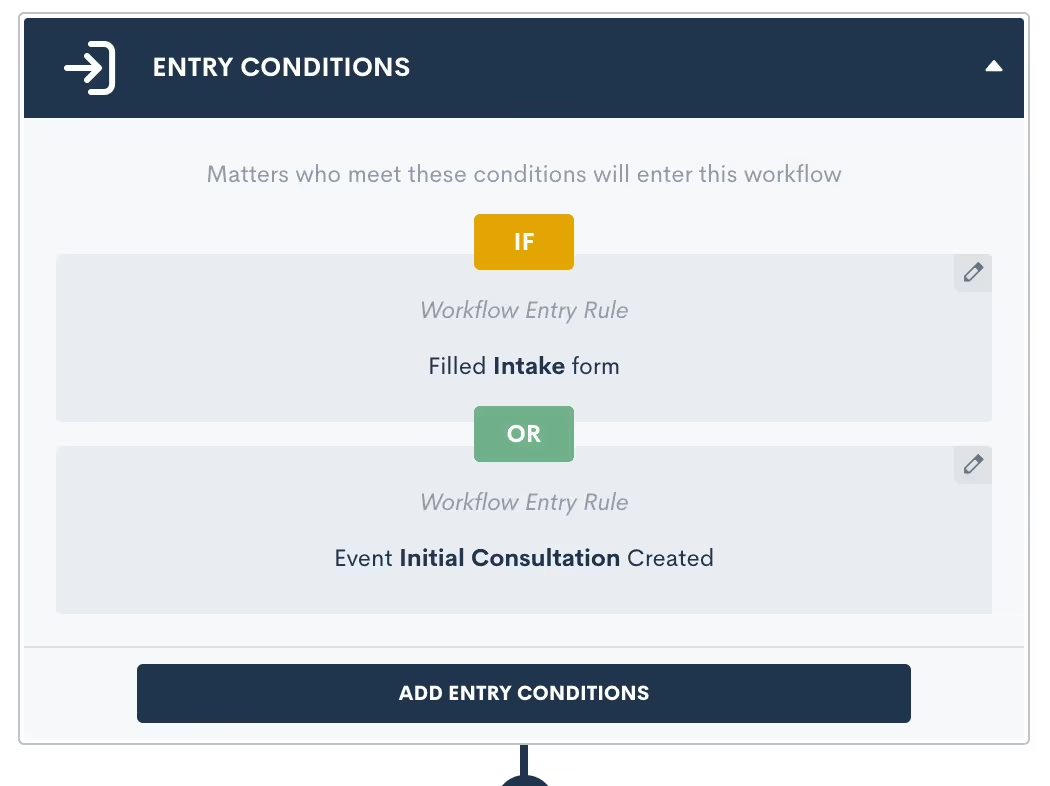
Pro Tip: There are certain entry conditions where it would not make sense to use an “and” relationship, so paying extra attention to the entry condition relationship will help make sure to avoid Automation mishaps. For example, a matter can never be multiple practice areas simultaneously or in different pipeline stages at the same time. For that reason, having an Automation triggered if “practice area = X” AND “practice area = Y” would not be a logical entry condition.
The match on fields entry condition option is a very powerful one, and also one that can cause some confusion and errors when not used properly. This trigger refers to the value of any data field being populated, so the Automation triggers when the specified value is matched.

For example, this Automation (above) will trigger when a matter enters the Missed Consult stage (AKA the stage field is populated as Missed Consult). Remember, Automations that use the match on fields entry condition will trigger as soon as the data is matched.
Pro Tip: Know your triggers! A common cause for Automation misfire is populating a field internally without realizing that this field is in use as an Automation trigger. If you are not familiar with your triggers then you may think you are just populating a field and unbeknownst to you have triggered an Automation. This problem can be easily avoided by keeping tabs on (or documenting) which fields you have selected as triggers throughout your workflow, and by being intentional when populating those fields knowing that they are an Automation trigger.
Action Items
Once you have selected an entry condition for your Automation you are ready to begin adding action items. While this step is overall a straightforward one, with the plug and play colorful interface, there are still several best practices to be aware of that can level up your Automation.One action item that you will undoubtedly use in plenty of your Automations is the time delay. As you may guess, this action creates a pause in your workflow for the duration of your choosing. This is particularly useful for drip campaigns, reminders, etc.
Pro Tip: When using multiple delay action items in an Automation, such as for a drip campaign, the time delays add on from the previous step. In the example below, the second email is sent after a one day time delay, and is then followed by a two day delay. When the next action occurs after that two day delay, it will be three days from the start of the Automation, since it stacks on to that initial one-day delay.
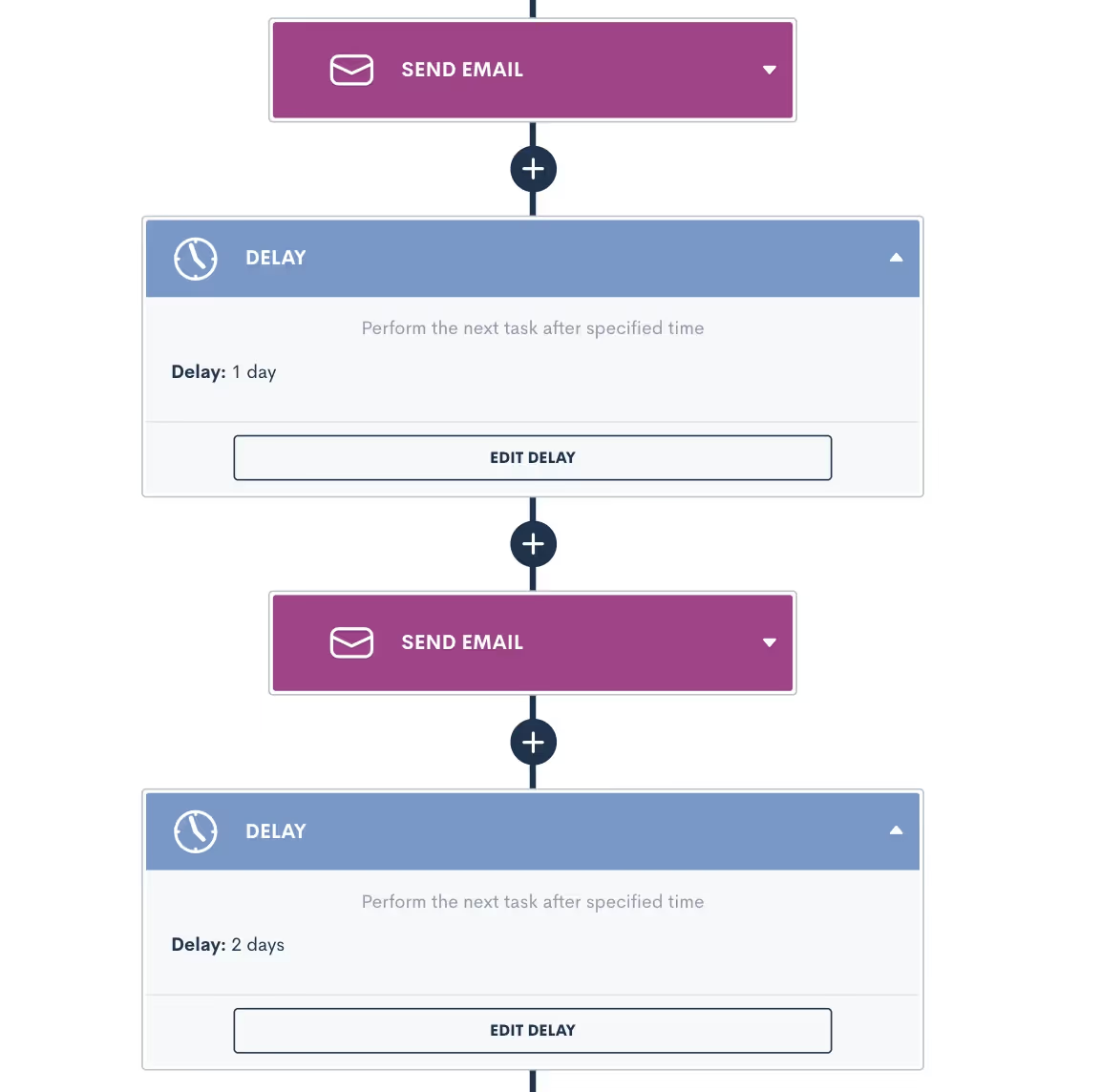
When it comes to the other options for automated actions, most are self explanatory but a few could cause you to slip up. Let’s review some other common mistakes and misconceptions when adding action items.
Create Appointment vs. Request Appointment
These two options may seem the same or similar at a glance, but they are actually very different. The Create Appointment action will book an event on your calendar with the target matter. This action is typically used for webinars or other events, since the event will be scheduled for a static date and time. This action books the appointment for the date that you have selected in the Automation, with no input from the client. Request Appointment on the other hand will send a link to the target and allow them to select their own appointment based on the host’s availability. This is a more commonly used action item in Automations.
Send Documents vs. Request Signature
E-signatures are collected from documents, so the send document action item may seem tempting as the correct one to use, but in actuality it is not the action you would use for e-signature. The Send Document action simply merges the target’s information into the document and sends it as an email attachment, with no e-signature involved. The Request Signature action is what you will use to send a document to someone for collecting an e-signature.
Sending Email to Recipient (Other Than the Automation Target)
By default, an email used in an Automation will be sent to the Automation target (AKA whichever matter is running through the Automation). If you select a recipient other than the target, such as a related contact or internal user, then you must specify whose data fields should be merged into the email, the Automation target or the recipient.
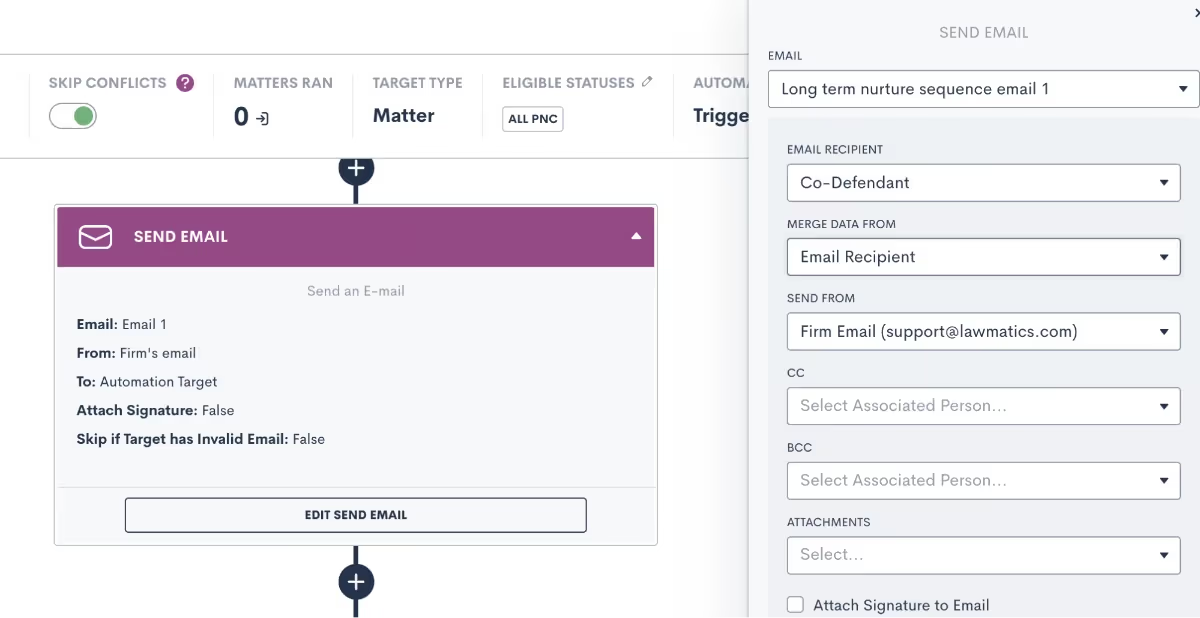
Pro Tip: Make sure you select appropriately so that any fields, such as first name, display the proper values. If you are addressing the email “Dear [first-name]”, then make sure you select the email recipient in the Merge Data From box, so that the recipient’s name will be merged in as opposed to the matter running through the Automation. If you need to reference the matter’s name in the email, for example if you are sending their info to another attorney as a referral, then you would select the Automation Target option for merge data from.
You cannot have some fields in the email template show the target’s info, and others display the recipient’s, so make sure you keep that in mind when building fields into an email template.
Matter Conversion
Use this action item to change a matter’s status from PNC to Hired once they have completed your intake process and hired the firm.
Pro Tip: This action item can only be used at the very end of an Automation, so you will only see it available to select when there are no steps following.
Sharing Items via Portal
The client portal is a useful tool for keeping clients engaged with their forms, documents, and other deliverables. Use an Automation to share any of these items to the client portal.
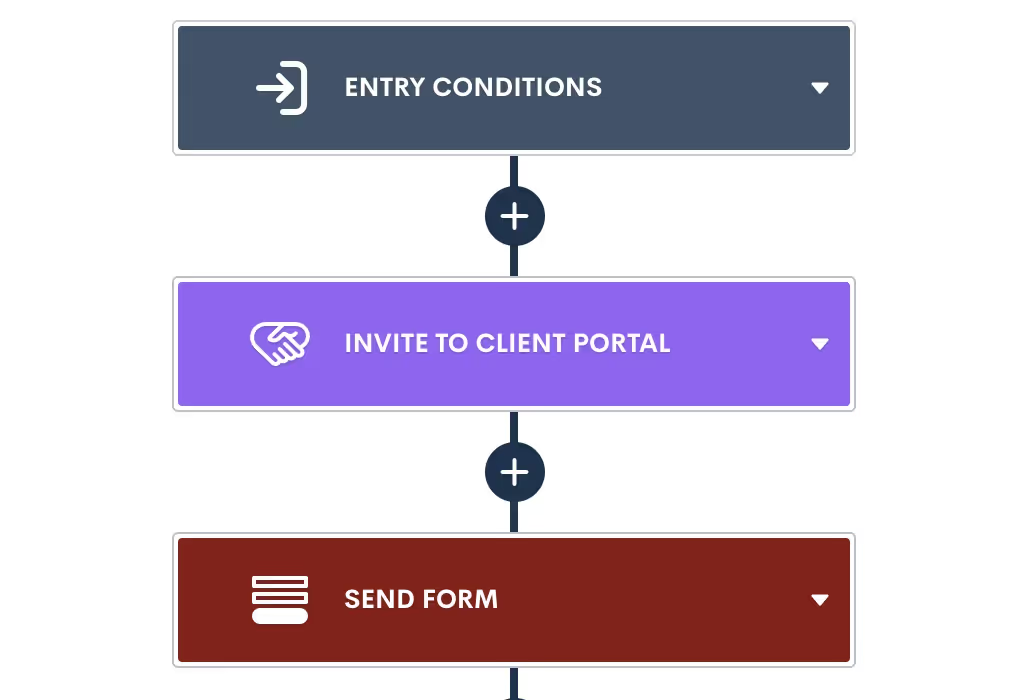
Pro Tip: You must first invite the matter or related contact to have access to the portal before any items, such as forms, can be shared. This can be done via Automation as well, just make sure to use the Invite.
Delivery Windows
As an Automation best practice, we recommend setting delivery windows on most, if not all, of your automated deliverables. Especially if you frequently find yourself burning the midnight oil, delivery windows make sure that your Automations don’t send something out at an off time.It's great to send emails, forms, and documents via Automation, but sending them during business hours can be even more useful to help increase your open rates. This is especially important for documents or other items that require prompt attention from the client or prospect.Delivery windows can be selected for any automated action items that are sent to a target, either via email or SMS. To set up a delivery window, click on the action item, and then select the window as shown below.
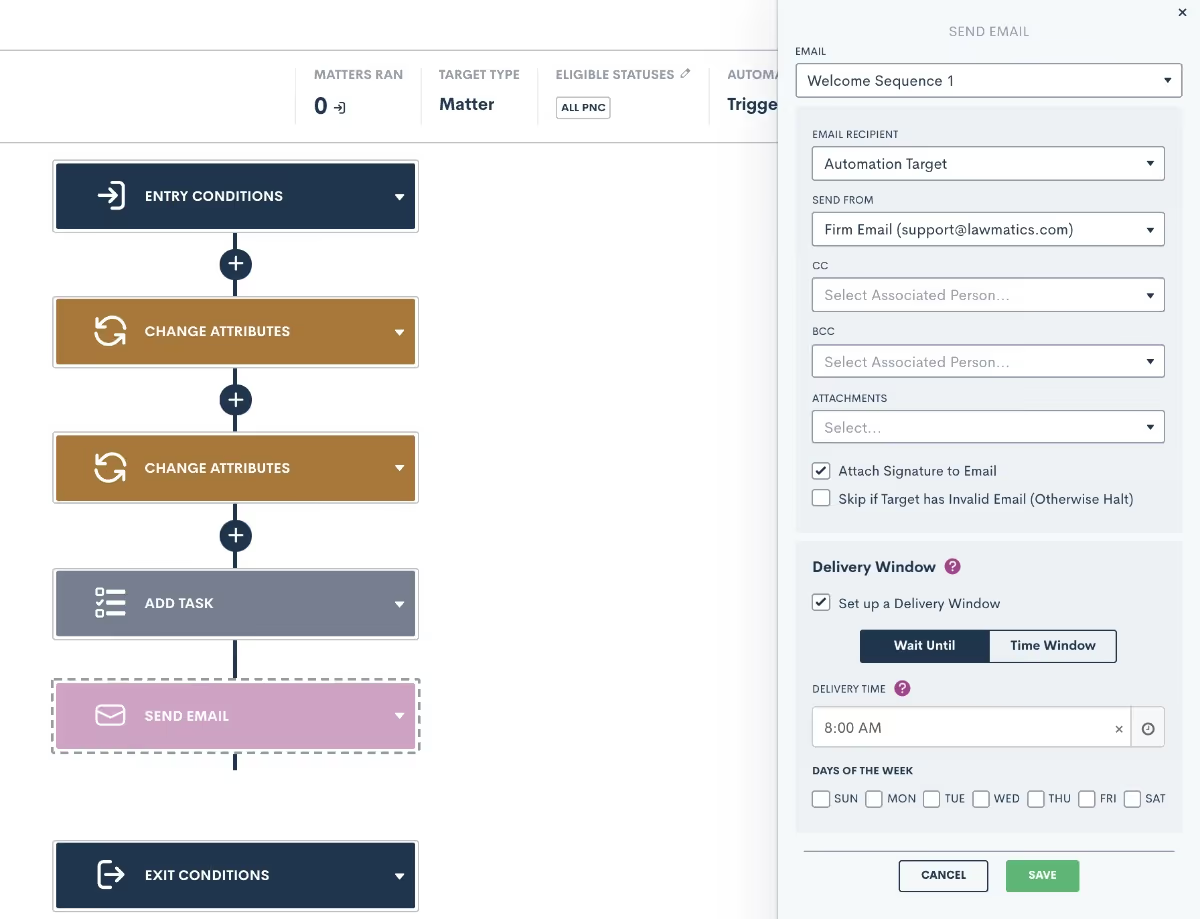
Pro Tip: You may choose the Wait Until option, to make sure the deliverable gets sent at a specific time, or the Time Window, which will allow it to send any time during the window of your choosing.
Conditional Logic
One of the biggest power features within Automations is conditional logic. This feature also has the potential to cause problems when not set up properly. When adding action items to an Automation, you will see the option to Add If Condition.If conditions work similarly to entry conditions in that they check if a particular condition is met, and trigger the appropriate action (side of the branch) when met or not met. When you select the If Condition action, you will see a menu on the right side of the screen to select which conditions should be checked for this branch.
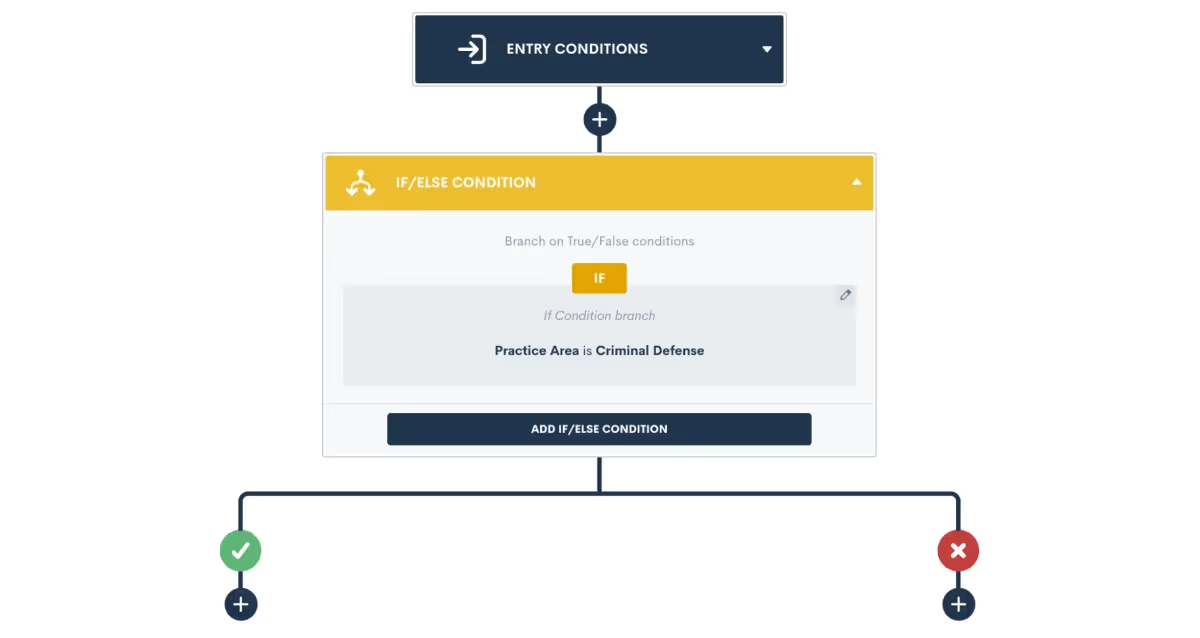
Once you select your condition and click save, you will see a branch created in your Automation. When the condition is met on a target in the Automation, they will flow down the "yes" (green check mark) side of the branch. When the condition is not met, they will head down the "no" side.
Pro Tip: It is very important to note that branches should only be used for conditions that are already determined at the time the Automation triggers, such as practice area, pipeline stage, marital status, etc. You should not use if conditions for sending reminders to fill a form/sign a document/book an appointment etc.
Once the condition is checked at the branch, the matter will flow down one of the two sides. At that point, the condition will never be re-checked (unless you have another if condition further on in the Automation). In other words, once a matter flows down one side of the branch, it will never go back to the other side.
Pro Tip: When editing an Automation, if you delete the if condition then all action items underneath it will also be deleted. For that reason, take caution when deleting a branch!
Exit Conditions
Exit conditions, although sometimes easily overlooked, are a surefire way to level up your Automations. Adding proper exit conditions to a workflow is the best way to ensure that matters only stay in a workflow that is still relevant to them.Let’s say you have an Automation that sends out a series of reminders for a potential client to reschedule their consultation after a no-show. This Automation would likely span over days, weeks, or even months, and would include a cadence of emails and/or text messages prompting them to reschedule. Now at any point if that PNC does in fact reschedule their consultation, you do NOT want them to continue receiving reminders from this workflow. Cue exit conditions.In this example, an exit condition of Event Created would be necessary to make sure that they exit once that appointment is booked. When you add exit conditions into an Automation, these conditions will be checked at each action item, and if the conditions are met, the matter will immediately exit the Automation and no future action items will run on them from that workflow.
Pro Tip: Exit conditions are not continuously checked 24/7, rather they are checked each time a matter hits the next action item. So let’s say you have a 3 day time delay in your Automation, and the matter meets the exit condition on the 2nd day of that time delay, they will not actually exit until the full time delay has run and the next action item is hit.
For that reason, it is crucial to think through your exit conditions carefully. Many users want to use a pipeline stage as an exit condition, but this can sometimes be problematic because the matter may already progress past that stage before the exit conditions are checked.With that in mind, the best exit conditions are ones that are “permanent”, meaning not a temporary status or a pipeline stage. Picklist fields or true/false fields make great exit conditions, since you will typically make a selection for those fields, and it will not change frequently like a pipeline stage would.
Conclusion
When done right, Automations are one of the best tools for saving time while also providing optimum communication with your clients. The best practices laid out here help you avoid any pesky issues that can cause your Automations to become troublesome.While building your Automations, keep in mind all of the various components, from entry conditions to action items to conditional logic to exit conditions, this will allow your Automations to work for you, instead of the other way around.Add these tips to your toolbox for creating your next Automation, and see how Automation can make your life much easier.
Meeting with your potential clients — whether in person or via video chat — is the ideal way to acquaint them with their legal counsel and your firm’s core values. In doing so, the initial consultation is a make or break moment in the client-attorney relationship, one in which you impress upon them the importance of your services in hopes that they select you above all others to represent them. However, this opportunity to showcase your value will be missed if the PNC is MIA for their consultation. Not only will it cost you hours of prep time but you are robbed of the opportunity to form that favorable first impression.Seeing as an initial consultation is a crucial step in your intake process, why not give it the attention it deserves? Lawmatics offers several easy ways to reduce, and possibly even eliminate, appointment no shows — and it all starts with booking.
1 Online Appointment Scheduling
The first step in getting someone to show up for a consultation is to, or course, schedule it. And with the right tools, achieving the critical milestone of securing a consultation appointment couldn’t be simpler.Lawmatics' legal calendaring software simplifies the process of scheduling in a way that makes it more likely for the appointment to stick, while also incentivizing the PNC to actually show up. If your firm is accustomed to a high volume of phone traffic for initial inquiry, one of the best ways for you to go about scheduling is from an internal intake form.

This form can serve almost as an intake script for your staff to intake new leads calling in, including a scheduling option. Depending on the nature of your clientele, it may be a big win to get a consultation booked, or it may be a run-of-the mill step of your intake process. Either way, the form can increase the probability of getting that appointment set by functioning as a reference document to inform your staff of what to say on an initial call.
Features to Use in Lawmatics
Booking Request Field
When building your intake form, we suggest using the booking request field to include a scheduling widget within the form that only shows the host’s availability. This feature makes it very easy to book when the caller is ready to set their appointment, Always make sure your firm’s Lawmatics users have synced their calendar in settings so that the system can be sure to pull their correct availability. This is a great way to simplify scheduling, since the intake staff can very easily select from times when the host is available based on their working hours, lunch time, other bookings, etc.

Booking Form
If your firm does not take many leads via phone, Lawmatics can automate your scheduling right from your website as well. Simply create a booking form and embed it right on your site. This will allow leads to see your availability right on your site, select a date and time that works for them, and confirm their appointment all without needing to speak to anyone.
Booking Link
Alternatively, you can also create a booking link in Lawmatics that can be linked on a button on your site. Add an eye catching call to action button, perhaps on your home page or contact page, and when a lead clicks on it they will be taken right to a scheduling page.
Request Appointment Email
If your firm is new to automation and looking for a manual approach to scheduling, Lawmatics has you covered there as well. You or your staff can simply go to a matter’s profile within the CRM, and click the Request Appointment button to send out a personalized email with a link for the lead to schedule an appointment based on the host’s availability.
Manual Booking
Looking for something even more manual? You can also go right to the Calendar to book an appointment at an agreed upon time there, or select the time yourself right from the matter’s profile.

Whatever method (or combination of methods) you choose, Lawmatics will turn your scheduling process into something you and your staff do not dread doing.
2 Automated Appointment Reminders
Now that you have a consultation booked, the next step in reducing no-shows entails reminding your leads of their appointment. Familiarly, this concept is standard practice with dentist’s offices or salons, so why not use the same tactic as a law firm? It should come as no surprise that Lawmatics has the tools you need to automate these reminders. Aside from reducing no-shows, automated appointment reminders create an overall smooth client experience requiring ZERO effort from you or your staff.Simply create the reminders once, and they will be delivered to the right leads automatically relative to the date of your appointment at a cadence of your choosing.
Features to Use in Lawmatics
Event Types
Your appointment reminders will be set up using an automation. Before you jump into creating the automation, familiarize yourself with the concept of event types. Your automation will correspond to a particular event type, such as initial consultation or follow up meeting, so it is important to make sure you are booking the proper type of event to trigger the corresponding automation.For the purpose of this example we will refer to the Initial Consultation event type, but keep in mind that reminders can be set up for any or all of your custom event types, as you see fit.
Email Templates
You’re but one step away from creating your automation. First, you will need to create a few email templates for your reminders. If you prefer to send your reminders only via text message, then you can skip this step, but we recommend sending a combination of both emails and texts for a higher chance of engagement.To create an email template, go to the Emails page under the Assets tab at the top of your page. You can choose to create your reminders as either plain text or HTML emails, the HTML emails tend to be more eye-catching and polished, whereas the plain text emails will appear to have a less-automated, more personalized touch. Whichever type of email you choose to create, be sure to use the event merge fields; these will populate with the prospect’s appointment date and time automatically once sent. This is where those event types start to come into play, you must make sure that you select the proper event type in your merge fields to align with the type of appointment you are building the reminder for. To send reminders for multiple different types of events, feel free to do so, but make sure you create a different email with the correct merge fields for each event type.
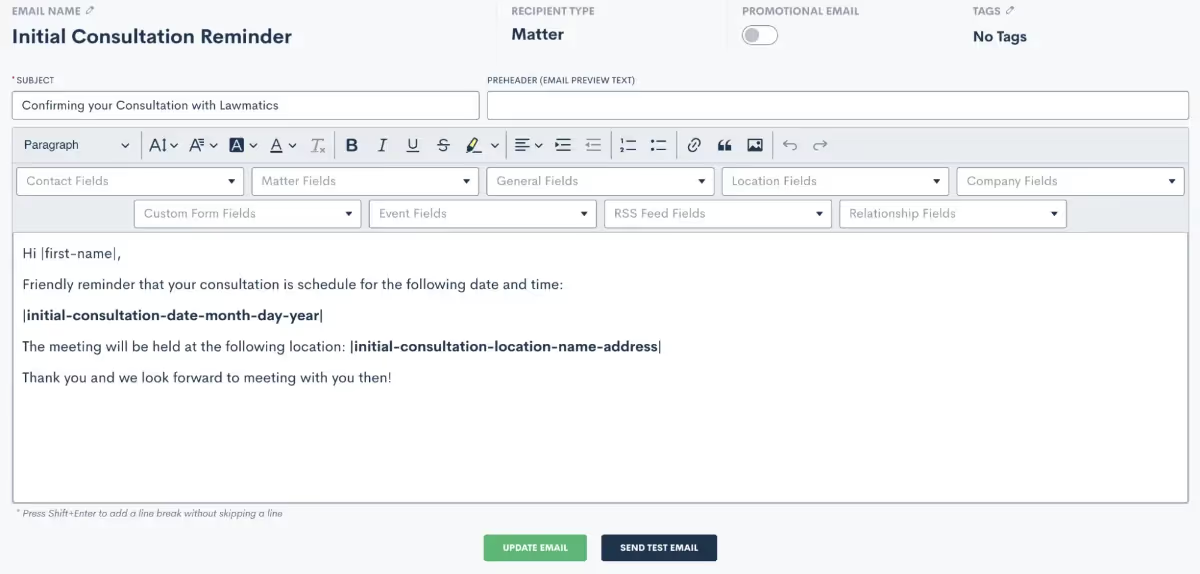
Create an Event Based Automation
Now that you have your email templates created, you are ready to create your automation. Use the Event Created entry condition, and then select the event type that corresponds with the fields merged into your email templates. Once you select the event created entry condition, the automation will become an Event Automation. This enables you to create time relative triggers to send out your reminders a certain amount of time before the PNC’s specific consultation date and time.Click the orange button labeled “Event Automations”, and then create a new event automation for the relative time that you wish to send out a reminder. Keep in mind that you can feel free to have multiple reminders, so if you want to send out an email 3 days before the event and then a text message 1 day before the event, you will create a separate event automation for each of those.

After you have created the necessary event automation triggers/timeframes, then click on each to add in your action items. This is where you will select the email templates that you already created, or use the Send SMS action to send a text message.
Rescheduling
If at any point a consultation is rescheduled, the event automations will update as per the new date and time, so your reminders will still be sent at the appropriate times based on the rescheduled time.These reminders are so useful because they will ensure that a lead does not fail to show as a result of forgetting the appointment with your firm. While there may still be external factors to miss an appointment that we cannot account for, you can at least take away the possibility of forgetting through the use of Lawmatics automated event reminders.
3 Actively Tweak Your Process
Even with digital scheduling and automated appointment reminders, the occasional no-show is inevitable. While the goal is to avoid this occurrence altogether, understanding why no-shows happen is key to improving your processes and reducing the instance thereof.
Tracking No Shows
Your first step is to locate the calendar event, either on the event calendar found under the CRM tab or on the matter’s profile, and then click the edit button. Here you will see a toggle button to label the appointment as a no show.
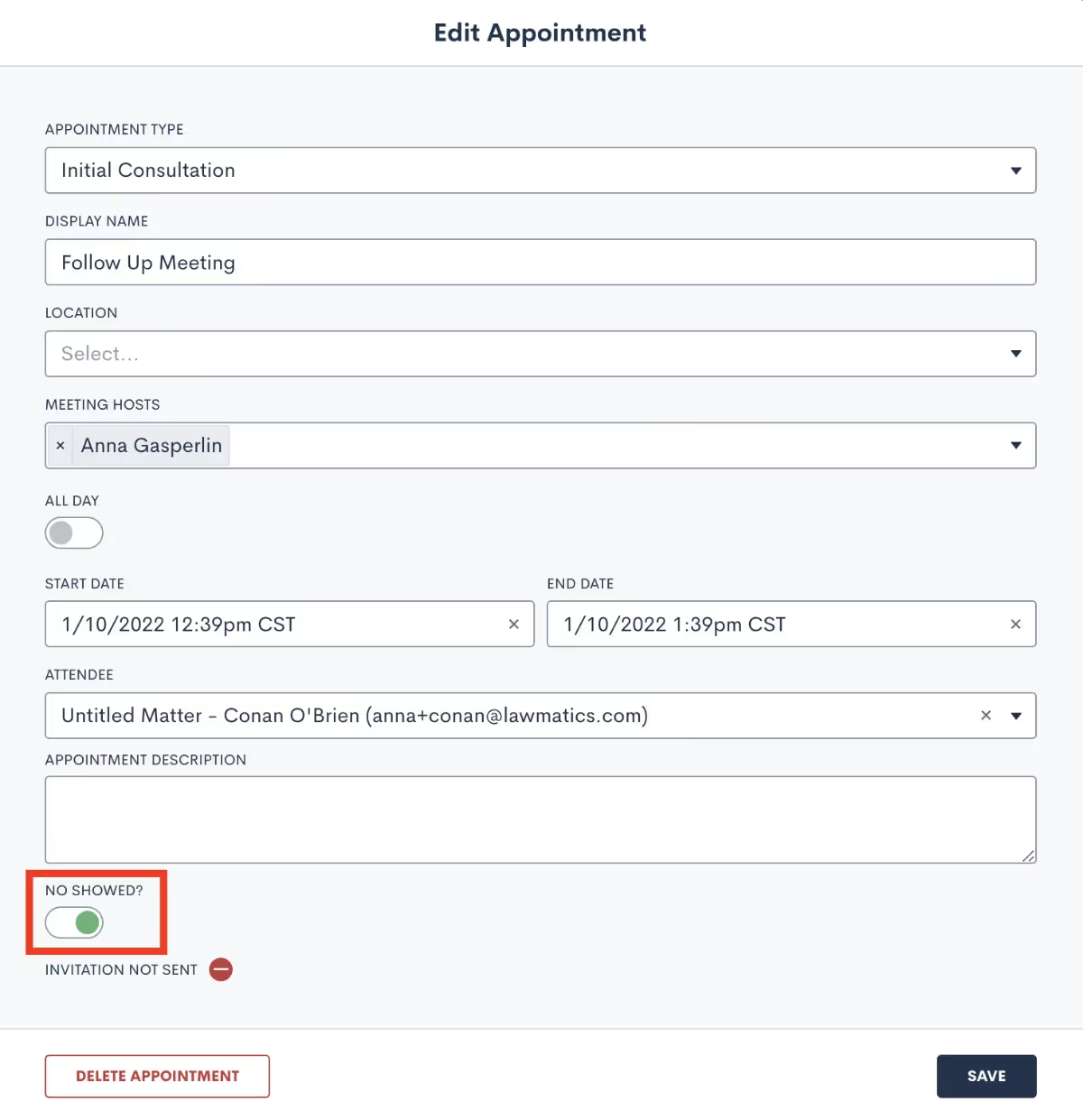
This is an important step for setting up reporting potential with our built-in no show analytics. Head to the Analytics page, found under the Insights tab at the top of your page. Here you will find a graph depicting your appointment show rates for each of your event types. You may notice that certain event types have a weaker show rate than others, which gives you a clue on where you may need to focus your efforts.Use this data to not only learn about the patterns of your no shows, but then take it to the next level by employing that data to make changes. Track your data over time and see if your show rates have improved as you have made adjustments and improvements to your process.

Automate No Show Follow-Ups
In addition to labeling the no show from the calendar event, you may also wish to create a pipeline stage or sub status for your no shows. The goal of this is to trigger an automation that will automatically follow up with, and hopefully reschedule, your no shows.Whether you decide to track these no shows using a pipeline stage, custom field, sub status, or any combination of those, this will be your trigger for the automation. Use the automation to send out an appointment request along with a nice email message letting them know that you’re sorry to have missed them, but they are still welcome to reschedule their consultation.
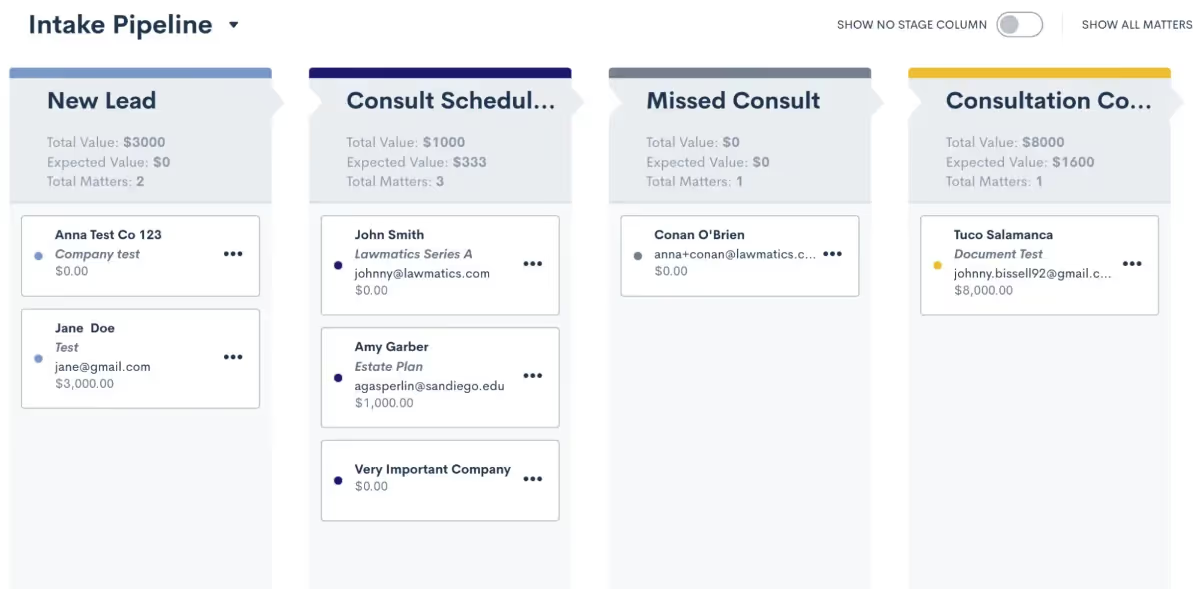
This is also a great opportunity to make a drip campaign of reminders for them to reschedule, spanning over weeks, months, or even years. Stay top of mind by setting up this cadence of check ins and reminders to reschedule, that way they won’t just become a dark lead after missing a consultation.
Conclusion
Your law firm has a personality as unique and individual as you, and meeting with a lead on a consultation is a great way to show off that personality. Maximize this potential by using Lawmatics to reduce your number of no-shows, giving all the leads a chance to meet and interact with you in person or virtually.With a smooth and streamlined scheduling process, you’re sure to make the initial appointment set up a breeze for both your leads as well as your staff. Between automated scheduling as well as reminders, you’re able to run your law firm’s appointments like a well oiled machine, without needing to lift a finger.All of this sounds great from a time-saving perspective, but at the end of the day it is also going to bring in more leads, create more happy clients leading to more referrals, convert more leads, all of this leading to more profits for you and your firm.
The Americans with Disabilities Act was enacted in 1990 to ensure public accommodations were accessible to everyone. But how does the ADA affect the public accommodations that have developed so robustly on the internet in the decades since the law was passed? Is your law firm’s website at risk of violating the ADA?In this webinar, Lawmatics CEO Matt Spiegel welcomes Jeff Lantz and Desire’e Martinelli of Esquire Interactive to explore these questions and more. Here are some of the highlights:
Who may be affected by website accessibility matters?
A broad range of disabilities or impairments may affect a person’s experience of a website. A person with one of the following disabilities or impairments may use assistive technology, such as screen readers or closed captioning, to navigate a website and its contents:.
- Visually impaired (legally or completely blind)
- Colorblind
- Deaf
- Physically impaired (motor/dexterity disabilities)
- Other disabilities (such as those affected by flashing technologies)
Significant uncertainty remains about what exactly must be done for websites to comply with the ADA, however website owners have broad discretion in implementing best practices for website accessibility.
What’s the case history on website accessibility and ADA compliance?
Two recent court cases have given some insight into how websites are to comply with the ADA:
- Robles v. Domino’s Pizza, LLC, No. 17-55504 (9th Cir. 2019) — If you sell goods and services directly on your website, it is critical that customers with different disabilities can understand and purchase the goods and services available.
- Gil v. Winn-Dixie Stores, Inc., No. 17-13467 (11th Cir. 2021) — While it was initially thought that Gil would formalize a distinction between sales and non-sales websites in terms of ADA compliance, a later appellate decision voided such a distinction.
While there are still no compliance standards, the Department of Justice provided guidance in March of 2022 on the flexibility businesses have in making their websites accessible. Businesses should consider the following matters regarding accessibility:
- Color contrast
- Color text cues
- Alternative text
- Video captions
- Online forms
- Text size/zoom
- Keyboard navigation
What are common ways websites violate the ADA?
The lack of specific requirements to make a website comply with the ADA did not stop the DoJ from initiating actions. Common areas of concern are:
- Images, buttons, and form fields are unlabeled or have inaccurate alt text
- Pop-ups are not reported to screen readers
- Tables are missing header information
- Missing or incorrect captions
Are there any guidelines for making my website accessible?
The World Wide Web Consortium (W3C) developed the Web Content Accessibility Guidelines (WCAG) to explain how to make web content more accessible for individuals with disabilities. WCAG covers webpages, applications, and other digital content in the form of “Success Guidelines.”The guidelines cover a wide range of matters, such as text size, contrast, navigation, website structure, alt tags, movement, and more. The guidelines are organized under the following four principles:
- Perceivable (captions, contrast)
- Operable (organization and navigation)
- Understandable (labels, user input matters)
- Robust (coding tags)
An accessibility compliance checker is a handy tool to scan your website for potential gaps in compliance, like missing alternative text or empty links. and should consider adding a way to report accessibility problems to the website owner.
Should I use an accessibility plugin for my website?
An accessibility plugin allows users to modify website features such as text size and color contrast to optimize accessibility. Although such a tool can help users understand how their information is presented, it may interfere with screen readers, ultimately making a website less accessible for some users.
Final notes and takeaways
The first step in evaluating your website’s accessibility is determining what level of compliance will be the standard for your website. This may follow existing guidelines, like WCAG, or you may choose to develop your own standards. Then, decide which of your website’s most frequently visited pages you’ll audit first. After an audit is completed, determine the process you’ll use to remediate any aspects of your website that may be noncompliant with the ADA.Although compliance flexibility gives website owners more choices in how they make their website accessible, some of the resulting ambiguity can make it hard to know where to start. Before you commit to a costly audit or remediation process, understand your risk of noncompliance, and make a strategic decision about your firm’s approach.To learn more about best practices for making your website ADA compliant, and to see more frequently asked questions answered, watch a recording of the full webinar.
Webinar slide deck
Personal injury law firms need to attract a steady and predictable stream of prospective clients to stay in business, and many have put a marketing strategy in place to do just that. However, to protect their bottom line and increase revenue, PI firms must understand how successful their marketing strategies are by analyzing their client acquisition costs.Client acquisition cost (CAC) is the approximate cost required to retain a new personal injury client, considering marketers’ salaries, the amount spent on marketing campaigns and strategies, and other advertising expenses. CAC can be measured through a simple calculation: the money law firms spend to obtain new clients, divided by the number of clients gained. It is always in a law firm’s best interests to lower its client acquisition costs. When CAC is too high, a firm might be losing money even as it attains new business if the investment to gain a client is higher than the lifetime earnings the firm receives through the representation of that client. Some marketers estimate that most CACs will be profitable if a firm spends 15 percent (or less) of their expected settlement on acquiring the lead. However, unlike flat fee or retainer-based cases that tend to yield a foreseeable amount, personal injury cases are hard to predict, and CAC depends on the settlement value of individual cases. If a firm wins more cases than it loses or tends to obtain higher settlements from profitable tort matters, it may be able to spend more on marketing. However, there are no guarantees.Here are some of the ways that personal injury firms can reduce their CAC costs:
1 Generate more cost-effective leads
Personal injury client leads come from many origins, and many don’t cost a lot of money. Here are some of the most common types of leads that can turn into paying clients:
- Organic leads – the kind of leads your firm naturally gets when prospects find you through keyword searches on Google or other search engines rather than directly visiting your website or clicking on an ad. According to MonsterInsights, the conversion rate for organic leads could be as high as 14.6 percent, making them an affordable and effective way for personal injury firms to find clients.
- Search Engine Optimization (SEO) – a strategy that involves the intentional use of keywords to online content to attract the right visitors, e.g., those looking for an experienced attorney to assist them with a personal injury matter. SEO, one of the most effective ways to generate leads and attract potential clients to your website, involves optimizing your site’s content with relevant keywords like “personal injury,” “car accident,” “injury lawyer,” “motor vehicle accident,” and “fair compensation.”
- Pay-Per-Lead (PPL) – some personal injury law firms pay an advertising affiliate for every qualified lead they generate under the terms of an agreement. PPL marketing can be a cost-effective, low-risk way to find leads since the marketing company must produce results to get paid; however, PPL does have drawbacks. For example, it can be a one-dimensional approach that favors quantity over quality, multiple attorneys may be getting the same leads, and no guarantees are made that the leads are considering hiring a lawyer now.
- Social leads – According to an Attorney at Work survey, 96 percent of the 302 lawyers who responded said they use social media like LinkedIn, Facebook, Twitter, and YouTube to bring in new clients. Personal injury attorneys who use social media can focus on having positive interactions with followers, while attracting leads often comes as a byproduct. By creating and sharing meaningful posts, videos, and images that encourage discussion among followers, lawyers can demonstrate their knowledge to potential clients without their efforts coming off as “marketing.” Posting engaging content on social media will also improve a firm’s ability to bring in organic leads.
- Referrals – When someone recommends your injury law firm to a friend or family member, they give you a referral. Research has shown that more people choose an attorney based on a referral from a friend, family member, or another lawyer than by any other method. Legal client relationship management (CRM) platforms help law firms manage and engage clients by automatically keeping track of critical information about them.
- Partner leads – Just because you can’t help a potential client doesn’t mean another attorney can’t. For example, when a lawyer meets with a potential client and realizes that a firm specializing in car accident cases would be a better fit, the best-case scenario would be for the attorney to hand off the case to a qualified personal injury attorney. Partnering with other lawyers to build a referral network can help everyone involved offer and receive quality leads. When you’re getting a large amount of business from lawyer referrals, that speaks to your excellent services and will encourage others to refer potential clients to you as well.
Personal injury leads can be challenging to come by, and even more difficult to convert. However, when you utilize the right strategies, encourage referrals, and provide a high level of service, the right clients will find their way to your firm.
2 Increase customer lifetime value
It is generally acceptable for firms to spend money on advertising campaigns to retain new clients. However, firms must also make critical investments in their existing client base to build, create and maintain positive relationships with current clients that will continue to increase over the years. While getting a prospective client to your firm’s door might seem challenging enough, firms must continually work to earn trust and loyalty to boost their customer lifetime value (LTV) and monetize their existing client base. Here are a few ways to increase LTV among your existing legal clients:
- Prioritize them – While no law practice can survive with only one client, clients still demand personal attention from their legal team. Making clients feel like their case is at the top of the priority list helps keep their anxiety at bay while enhancing their trust in their attorney.
- Set goals – Each client has different goals regarding the outcome of their case. Legal professionals need to understand client expectations at the beginning of the case because whether their goals are met will likely determine how satisfied they are with the overall representation. Knowing these goals from the onset will also help the legal team manage client expectations throughout the process.
- Be responsive – Law practice management software helps legal professionals manage client communications by allowing them to access client and case files anytime and anywhere. In addition, an agile attorney-client management platform for law firms will provide comprehensive support services that automate the intake process, scheduling, reminders, follow-up, workflow, billing, and more.
- Personalize your services – Try to meet with your clients in person occasionally, if possible, to get to know them. Ask them a little bit about their background, family, and interests so that you will be able to discuss something with them besides their legal matter. Clients don’t usually want to talk business all the time and appreciate it when you show interest in them as a person.
- Be prepared – You should encourage clients to come to meetings prepared and give them the same consideration. Your degree of preparation builds rapport with the client, helps you make the most of the time you spend with them, and demonstrates that you value their time and take their case seriously, which will, in turn, strengthen their loyalty to you.
- Stay in touch – One way to enhance the client relationship is to conduct regular consultations with clients in the office or online to get a sense of their approval or dissatisfaction and deal with any issues before they poison the attorney-client relationship. You can make more time for your clients by automating routine, time-consuming tasks with practice management software.
- Meet deadlines – If you want to build and maintain client trust and loyalty, getting work done efficiently and on time is essential. Legal technology can drive efficiency by automating and streamlining tasks that would otherwise require tedious manual processes and time lost, regardless of practice area. For example, for those who practice in the personal injury space, a legal CRM can provide templates, generate complex documents, manage files, automate time and billing, and present an injury case in the most compelling way possible.
- Be a strong advocate – Since they are often paired against insurance companies with deep pockets and specialized lawyers who work only for them, personal injury attorneys must also be strong advocates for their clients. Although no attorney wins all their cases all the time, it is vitally important that you win over your clients by building and maintaining solid relationships with them.
- Encourage honesty – All relationships function best when both parties are open and straightforward. One of the best ways to maintain positive relationships with legal clients is to be honest and encourage honesty. Answer all questions as truthfully as possible, and if mistakes are made, admit them immediately. Also, encourage your clients to be honest by emphasizing that if they fail to provide truthful information, this could negatively affect your ability to represent them.
To build strong professional relationships, a legal CRM is an excellent tool for managing personal injury leads, prospects, and client contact information.
3 Automate your marketing efforts
Law firm marketing strategies are often complicated and time-consuming. Legal professionals are always busy and under constant pressure – the last thing they want to do is focus on time-consuming marketing strategies. However, marketing automation allows law firms to stay ahead of the competition by automating various marketing tasks such as email, social media, lead generation, and data analytics.Automation software streamlines the entire client communication process to deliver the right messages at the proper time to the correct leads. In addition, automation platforms provide firms with essential data tools that provide valuable insight into potential clients’ behaviors that they can use to formulate actionable steps. Here are some of the benefits of marketing automation for law firms:
- Collect critical data – No more wasted time chasing a lead that might prove to be futile. Automation tools collect and record data about your prospects’ behaviors, allowing you to manage contact lists, plan actions, and follow up as needed to nurture your prospects from initial inquiry to paying clients.
- Maximize social media – Automation tools allow users to enhance specific actions on social media platforms, eliminating the need to carry out tedious tasks. For example, through automation, a user can schedule a social media post to go live at a designated time and subsequently analyze the post’s performance to determine its performance.
- Streamline workflows – Law firm marketing strategies require a long-term approach. Automation offers firms the ability to set up dynamic email workflows for all marketing approaches.
- Enhance customization – Legal CRM systems can customize all alerts, follow-ups, and digital intake forms, allowing teams to target their communications to create audience segmentation and engage leads to retain their business.
- Save time – Automation actions can be set up to send emails, update social media, launch newsletters, answer FAQs for clients, provide and receive client updates, and present performance surveys. These capabilities save legal teams countless hours while increasing the firm’s bottom line.
- Measure performance – Automation provides various performance indicators that measure return on investment (ROI), conversion rate, and cost per lead. In addition, the software allows users to track what visitors do on their website, evaluate advertising campaigns, oversee social media, and use public relations outreach services as a part of the law firm’s marketing strategies.
- Improve communication – Some believe that automation creates mass-produced communications such as emails with little or no personalization. However, automation tools provide customization options using innovative artificial intelligence (AI) that allow firms to segment leads, personalize communications, and give the unique information sought by each potential client.
- Track budgets – Marketing automation lets legal teams know exactly where their money is going and helps them determine if they want to spend additional funds on advertising. If they decide to expand their budget, automation enables them to pinpoint the best use of funds: should they beef up their website’s content, launch an email campaign, send out a newsletter, or escalate their digital marketing reach?
Lawmatics offers law firm CRM for attorneys who want to take their firms to the next level with powerful, easy to use, and effective software solutions. Our marketing automation system takes care of everything from the initial first contact through becoming an established client to help ensure your firm’s marketing approaches are on target.
Ready to lower your firm’s CAC and boost client acquisition? Lawmatics can help
Want to take the next step? Contact us to learn how Lawmatics legal automation software can help you turn all your law firm marketing strategies into realities.
We’re delighted to announce that Lawmatics has been recognized by TechnoLawyer as a ‘Hot Product’ in their 2022 Buyer’s Guide. The TechnoLawyer publication reports on the latest in legal technology, law office management, and law firm management.“We’re extremely proud to be identified as a premier tool for helping law firms grow,” said Matt Spiegel, CEO of Lawmatics. “Our software empowers law firms to spend less of their time on administering the business of their practice, and more time focusing on the clients they serve. We know that firms thrive when they can prioritize people rather than paperwork.”This honor is just the latest acknowledgement of how our client relationship management (CRM) software is revolutionizing law firms’ approaches to marketing, lead management, client intake, client reengagement, timekeeping, and billing.TechnoLawyer cited Lawmatics’ powerful and versatile automations as our ‘killer feature.’ Together with the workflow pipeline, Lawmatics automations seamlessly guide firms and clients through every stage of the intake process.
“You can build an unlimited number of automations in Lawmatics, each of which starts with one or more triggers. Triggers include events, completing a task, a form submission from your website, receiving or sending an email message, requesting files, and various client actions such as signing a document or paying an invoice.”
Other features highlighted in the buyer’s guide
- Unlimited custom fields
- Document building
- Email templates to communicate with prospective clients
- Time and expense tracking
Check out the full TechnoLawyer Buyer’s Guide review here. To see these features in action, book a free demo.
Subscribe to get our best content in your inbox
Ready to grow your law firm with Lawmatics?
Schedule a demo of legal’s most trusted growth platform.
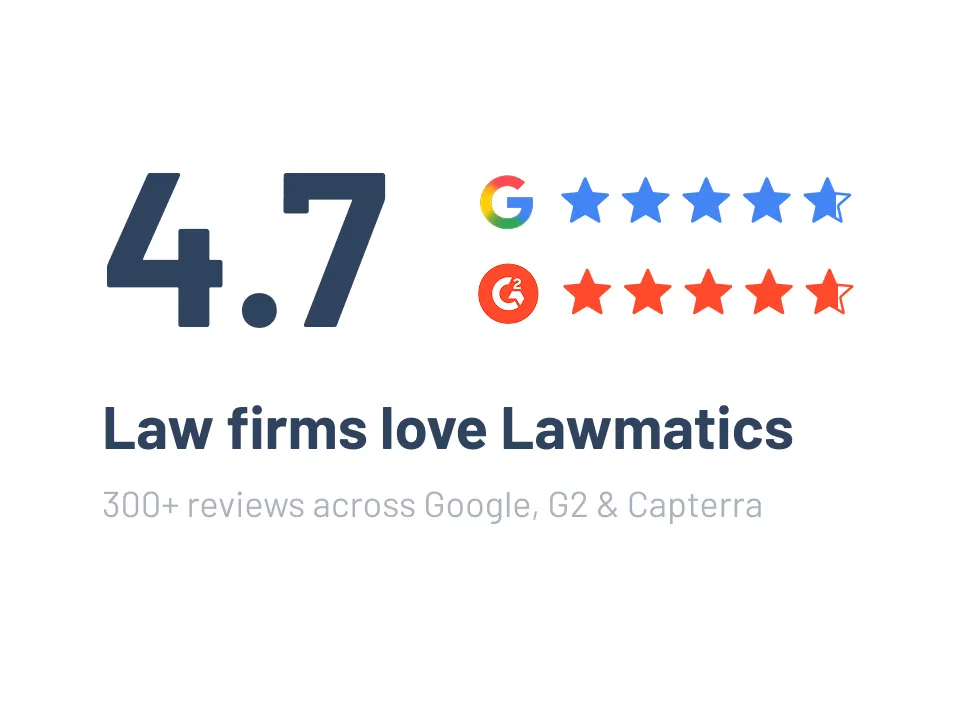




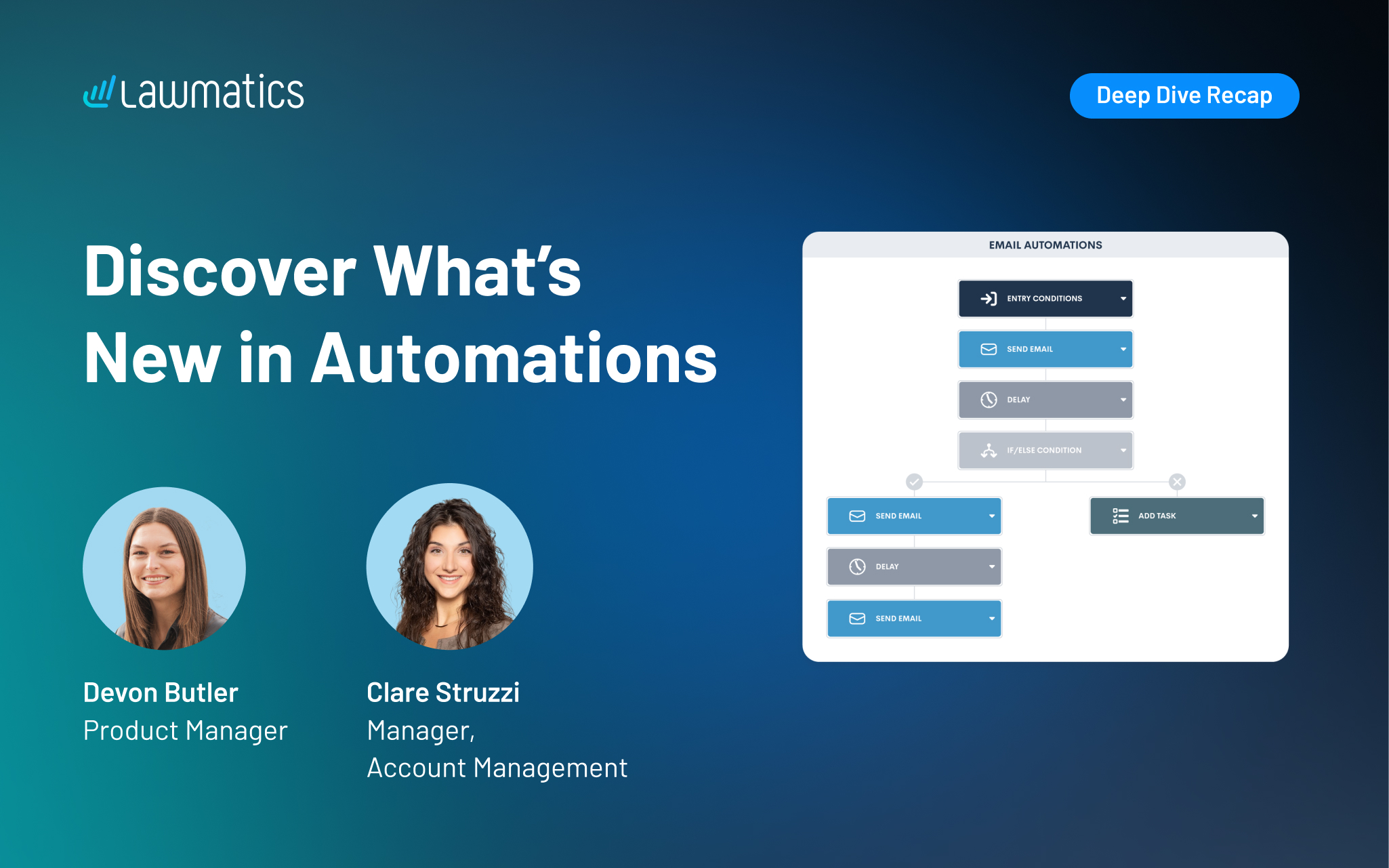


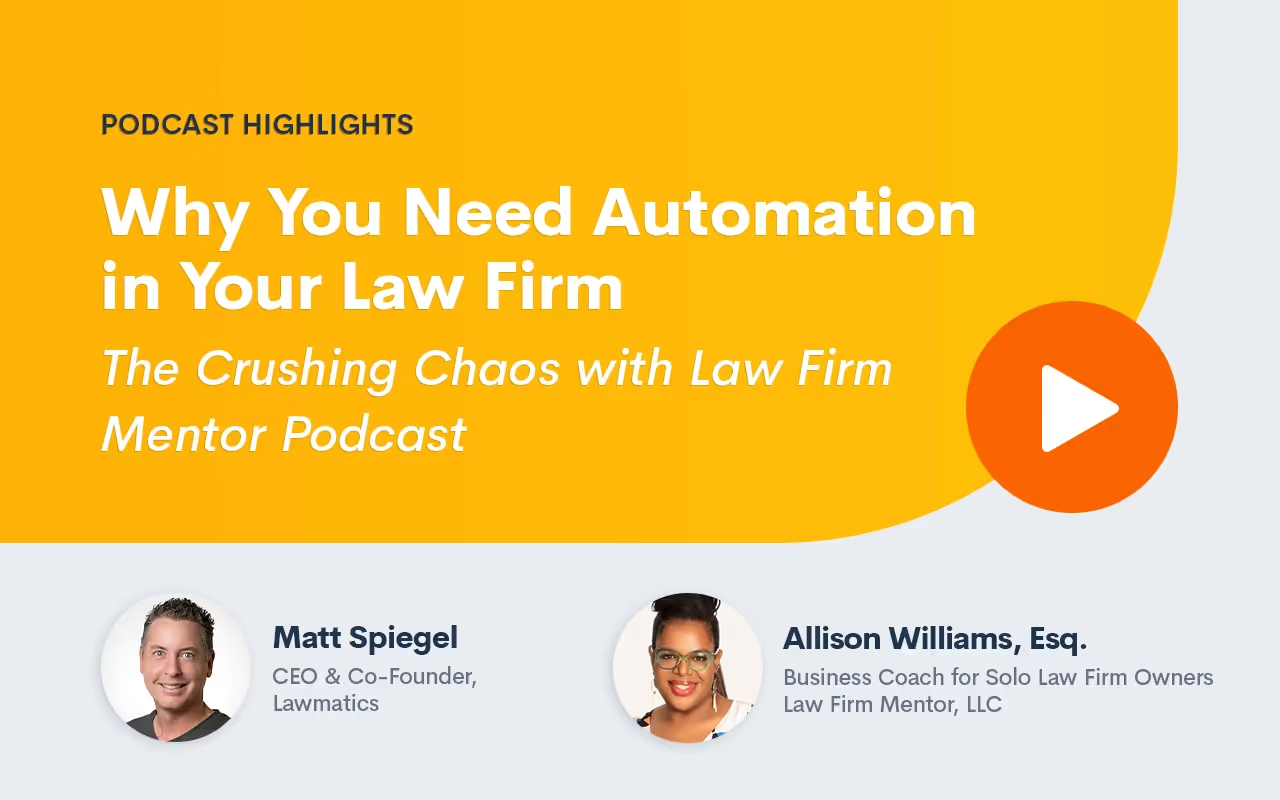
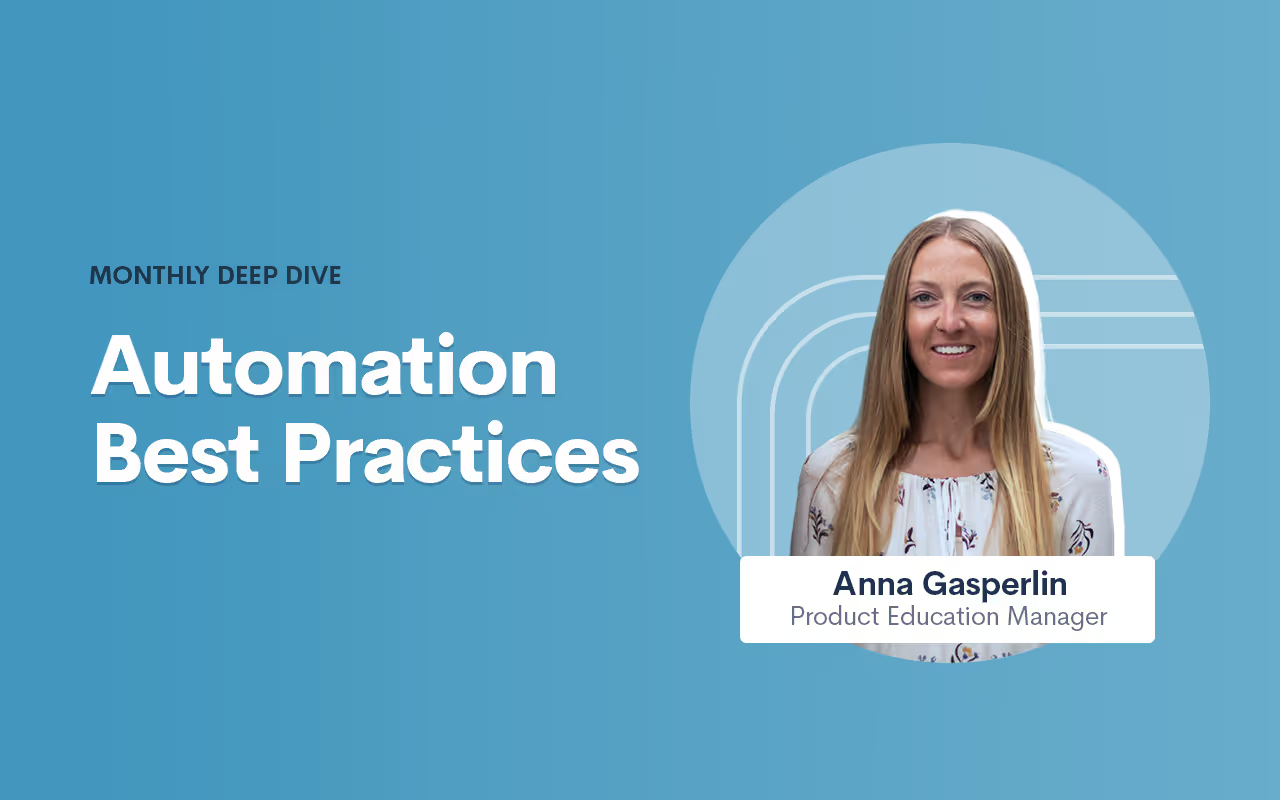
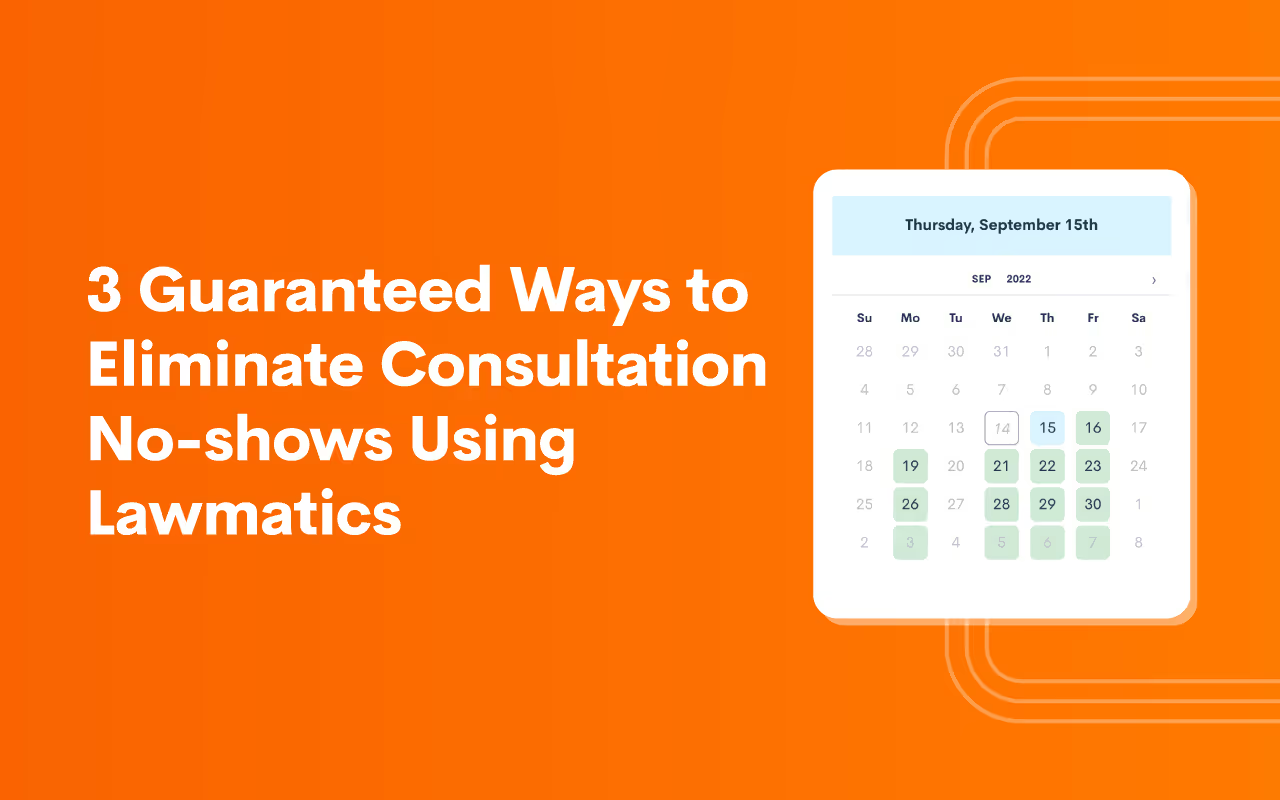

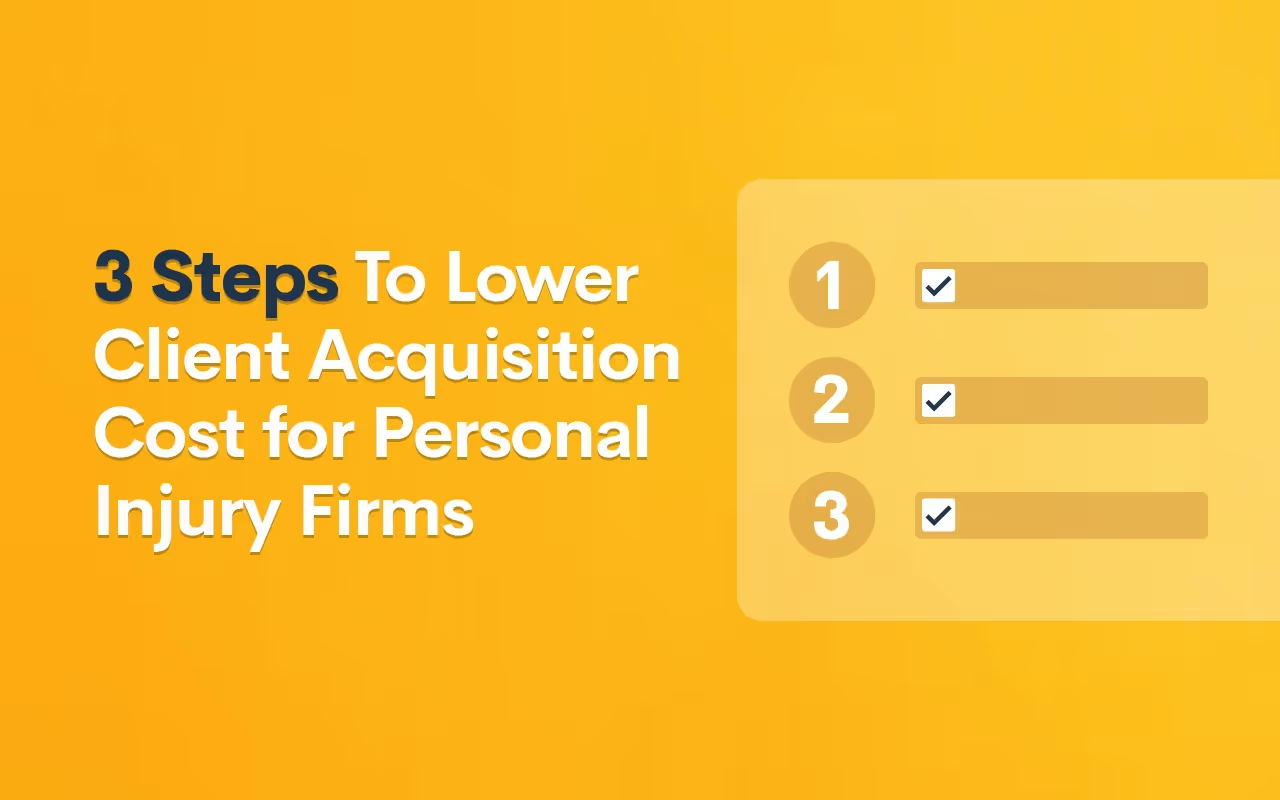
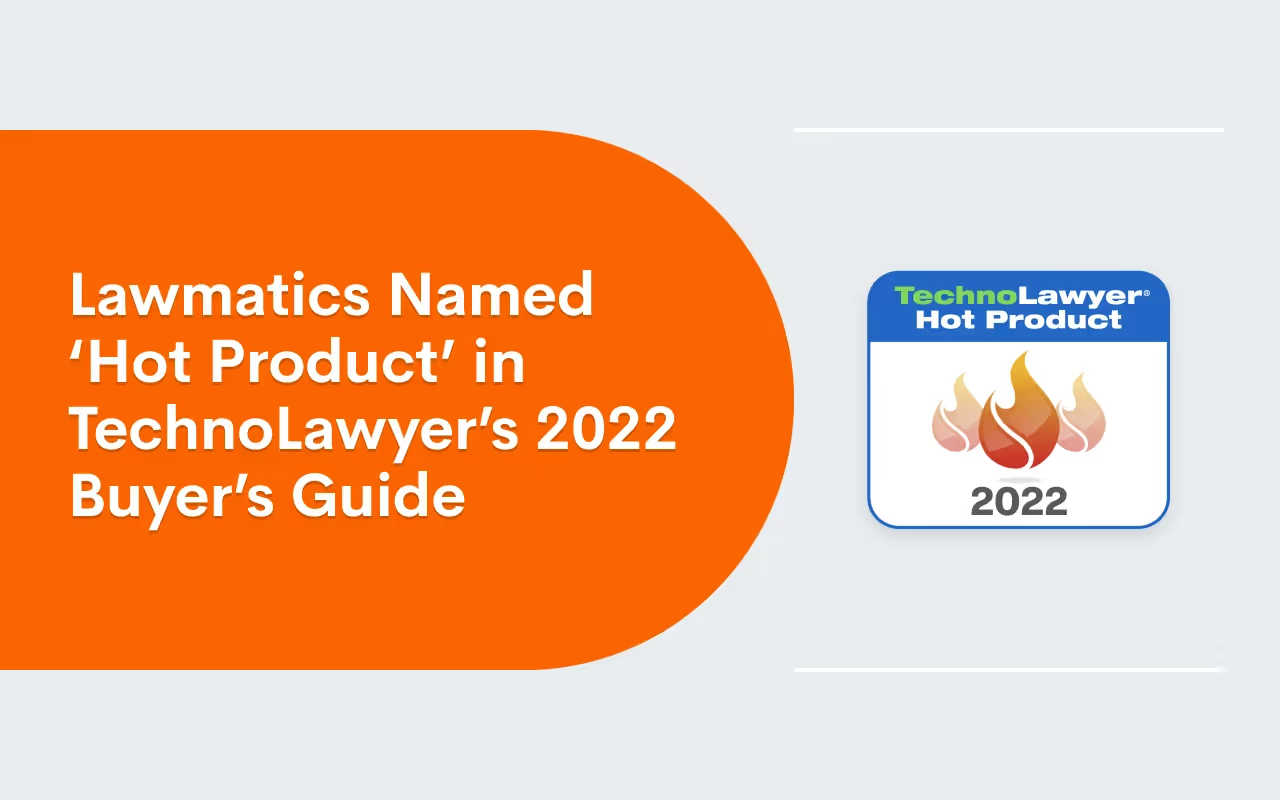
.avif)
.avif)

.avif)
